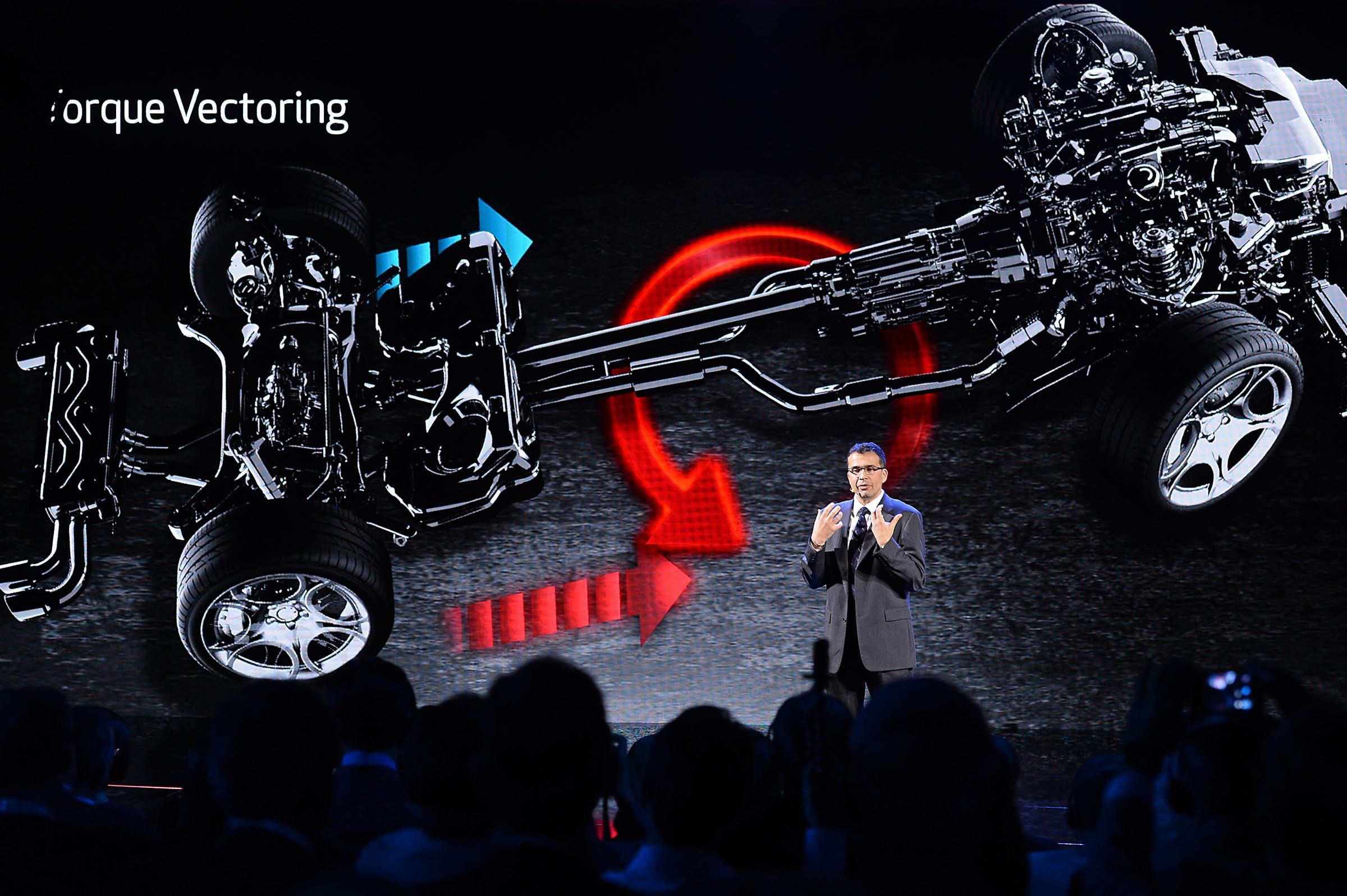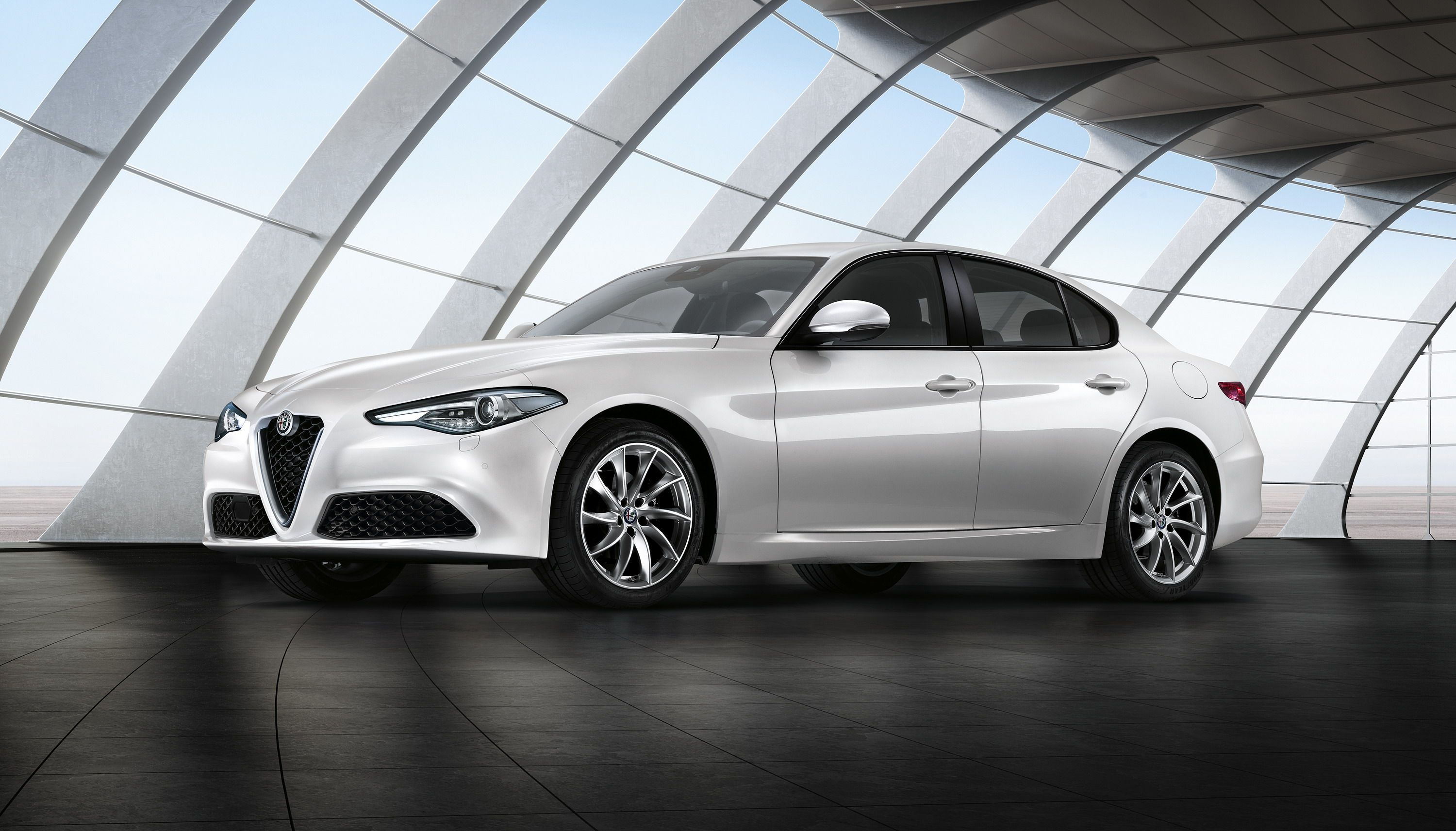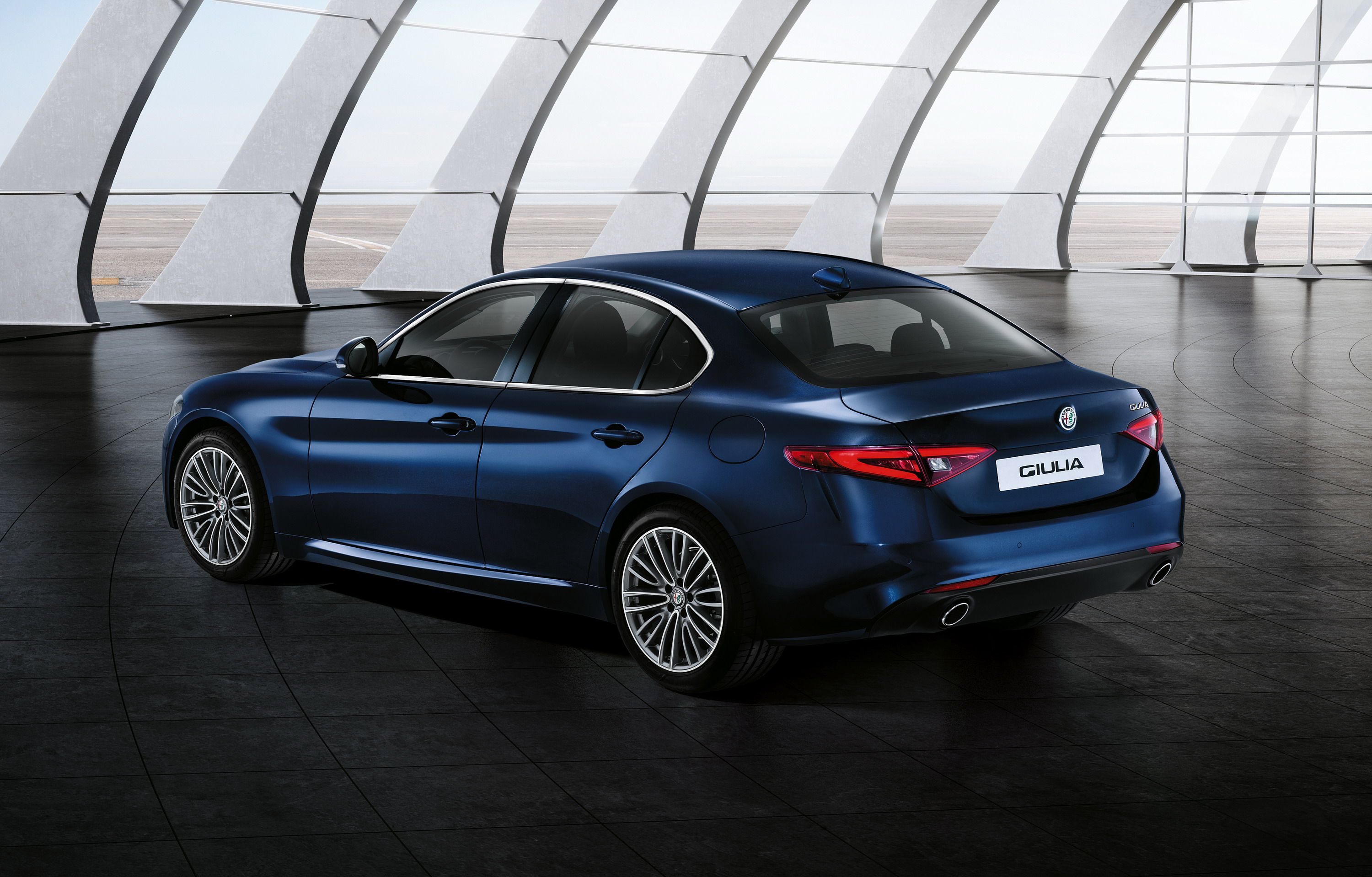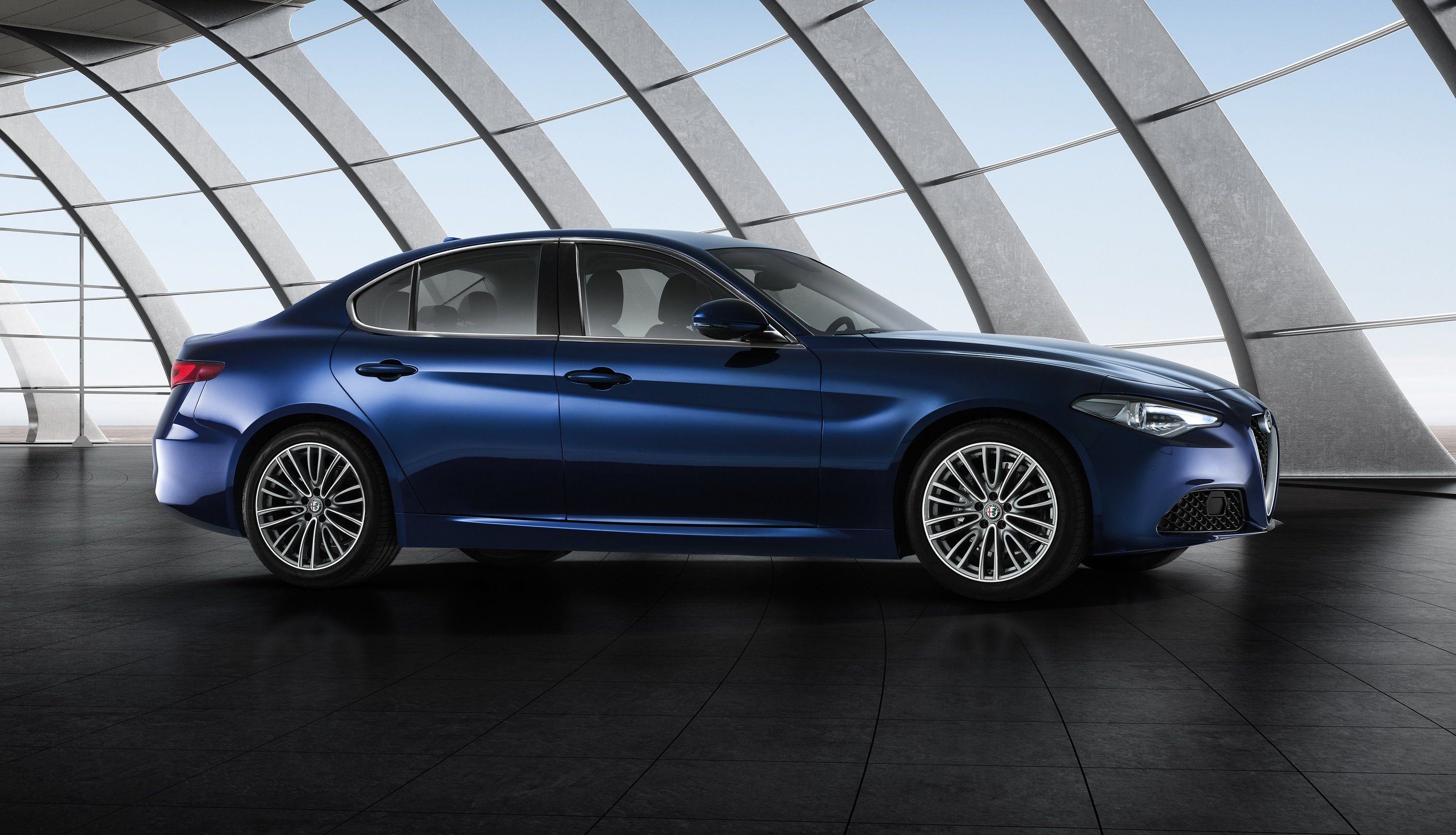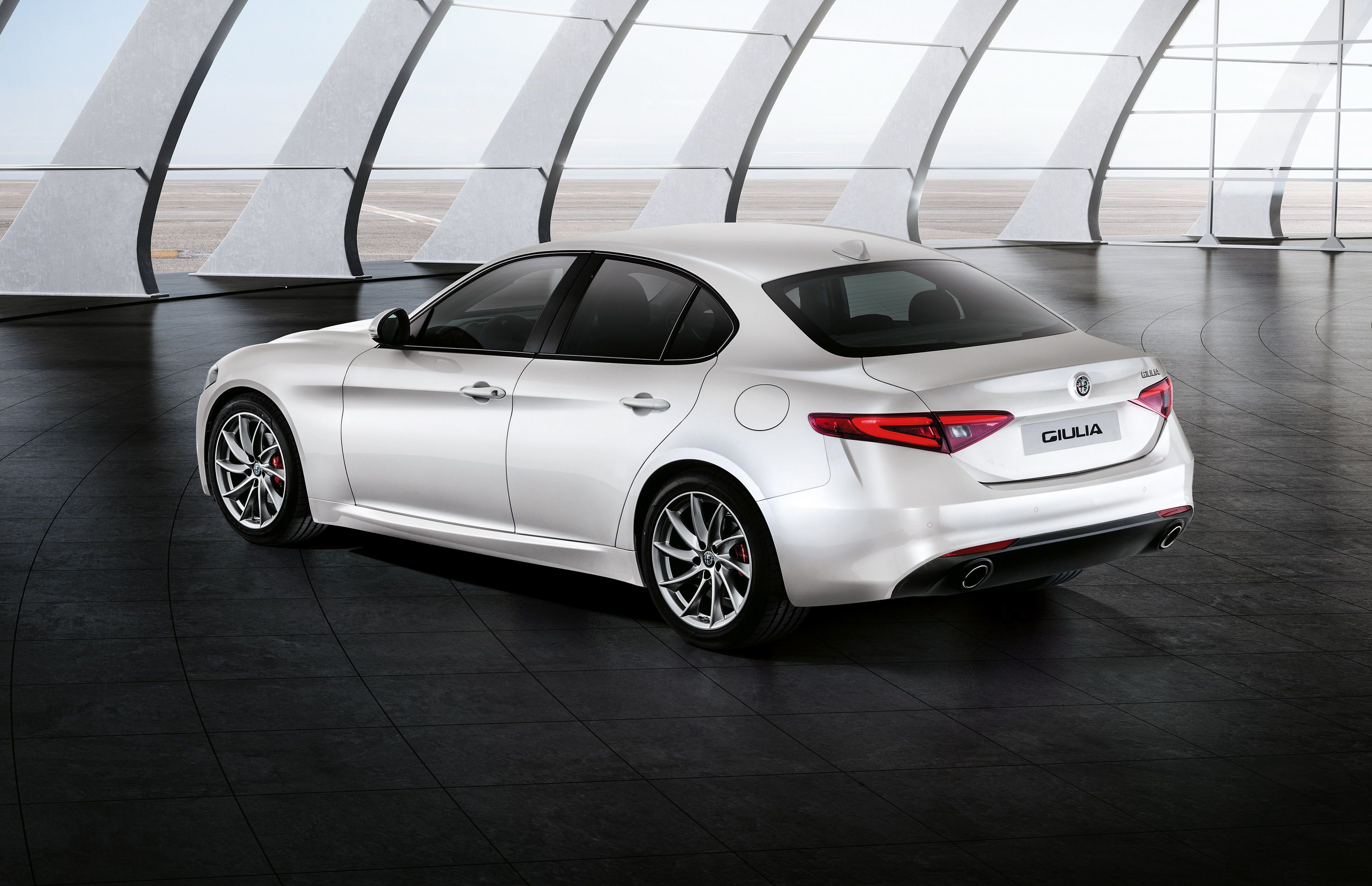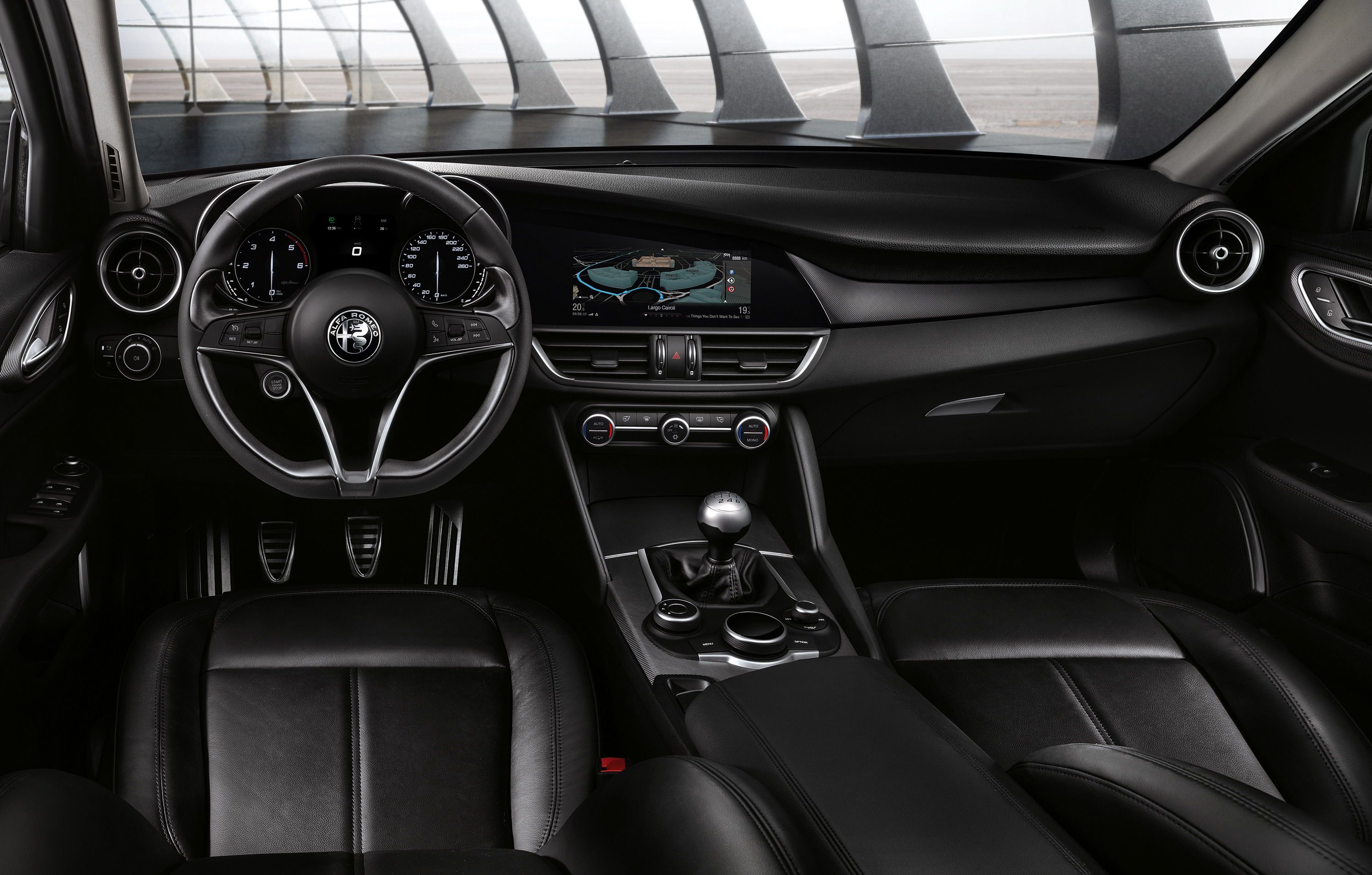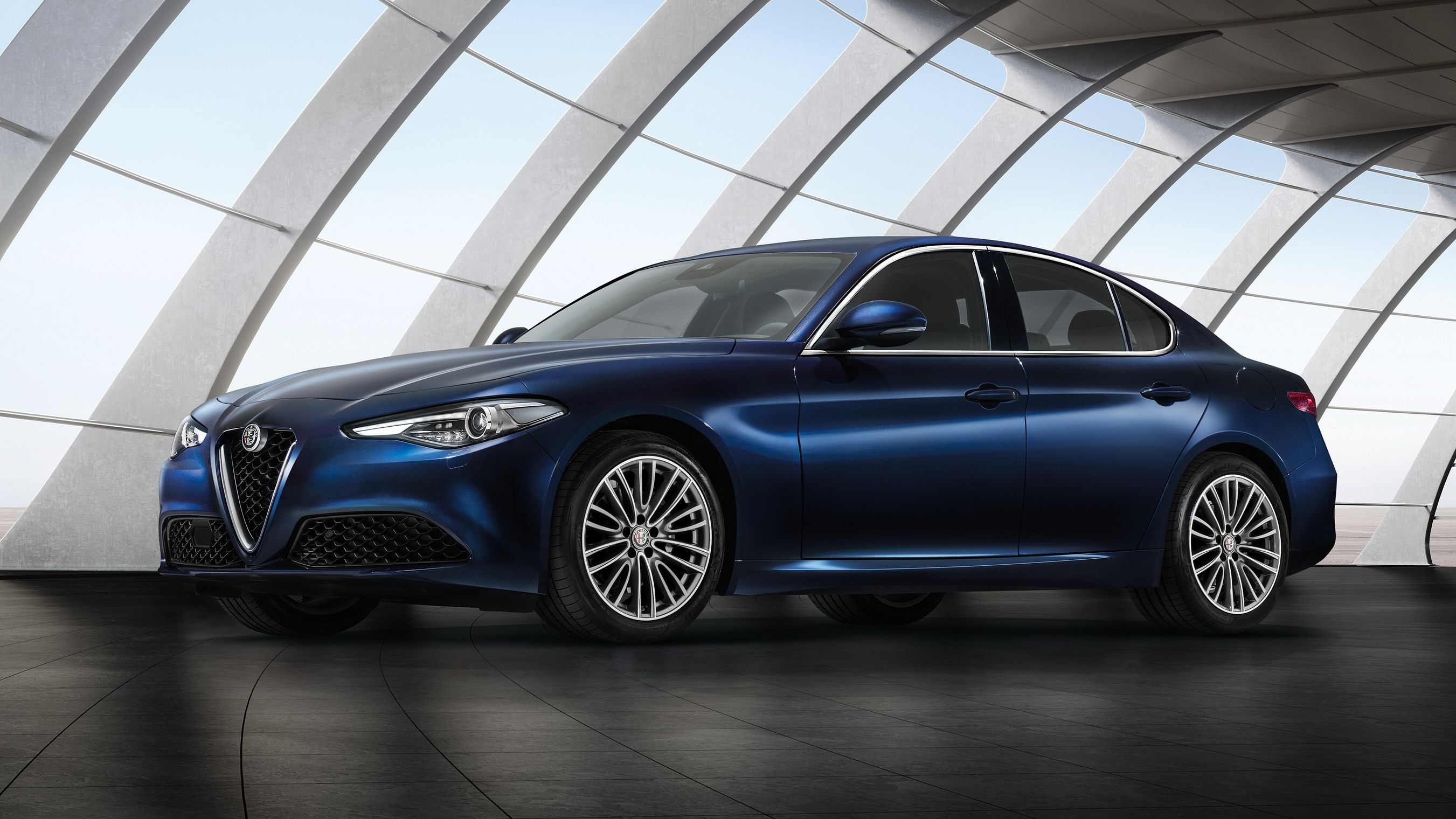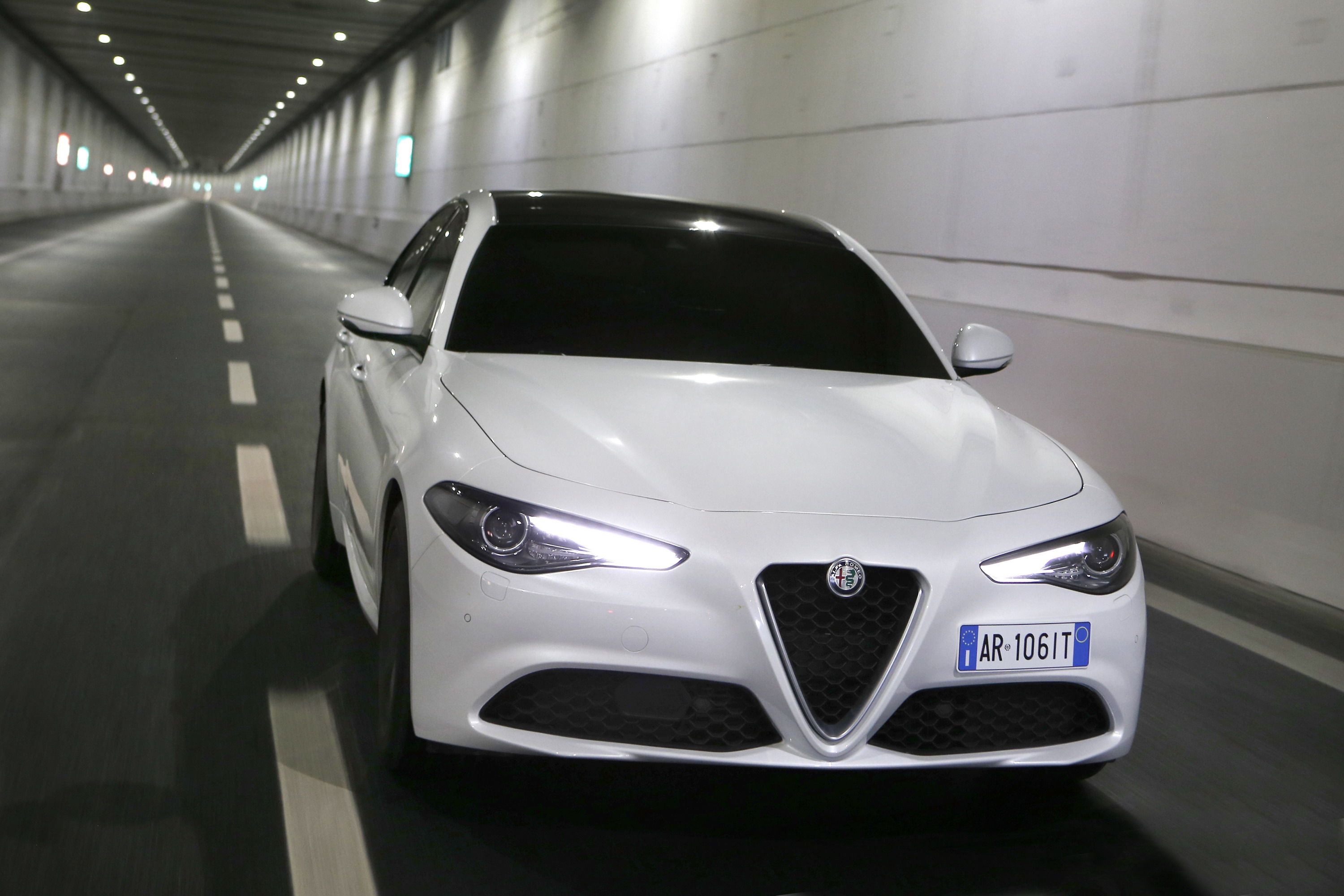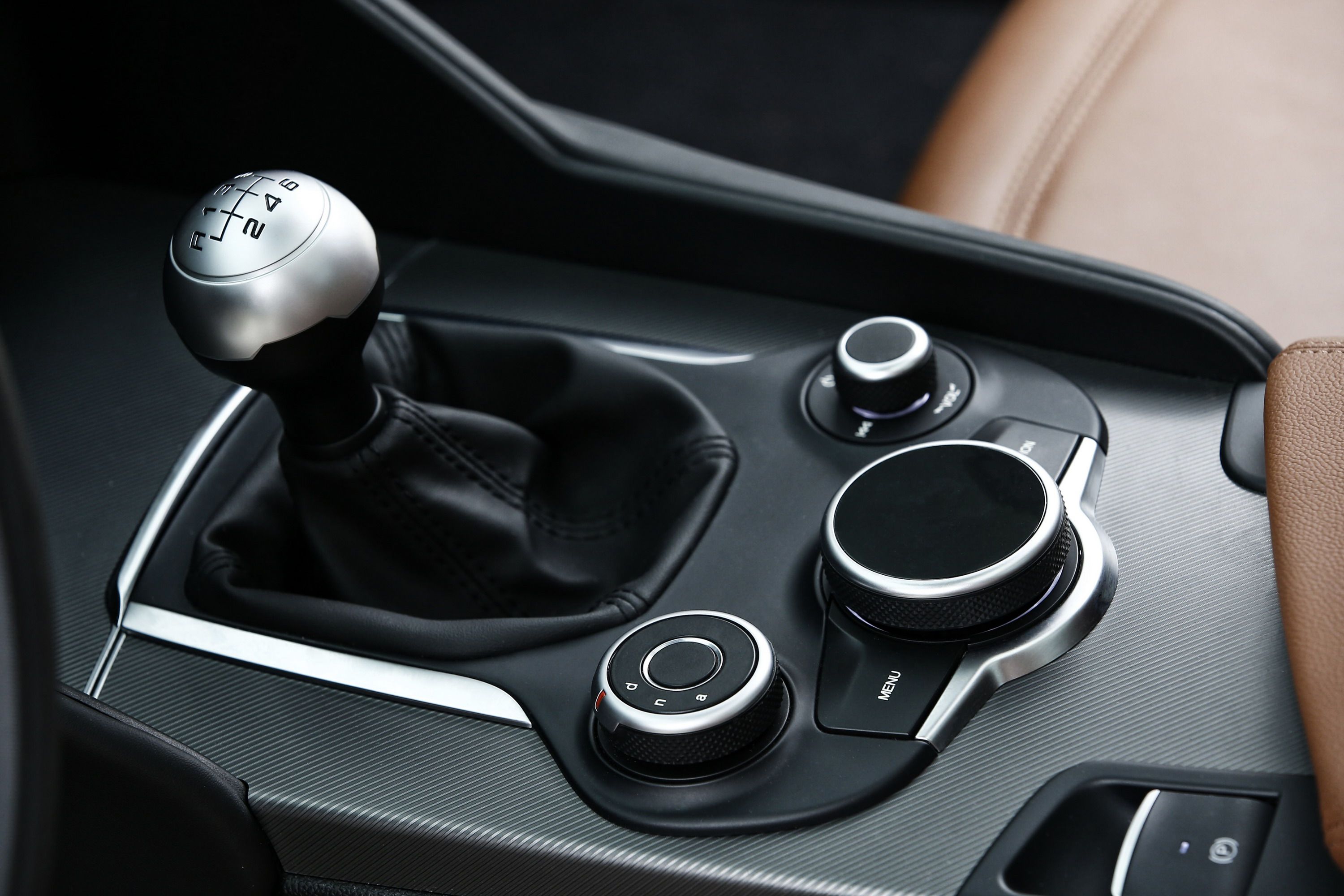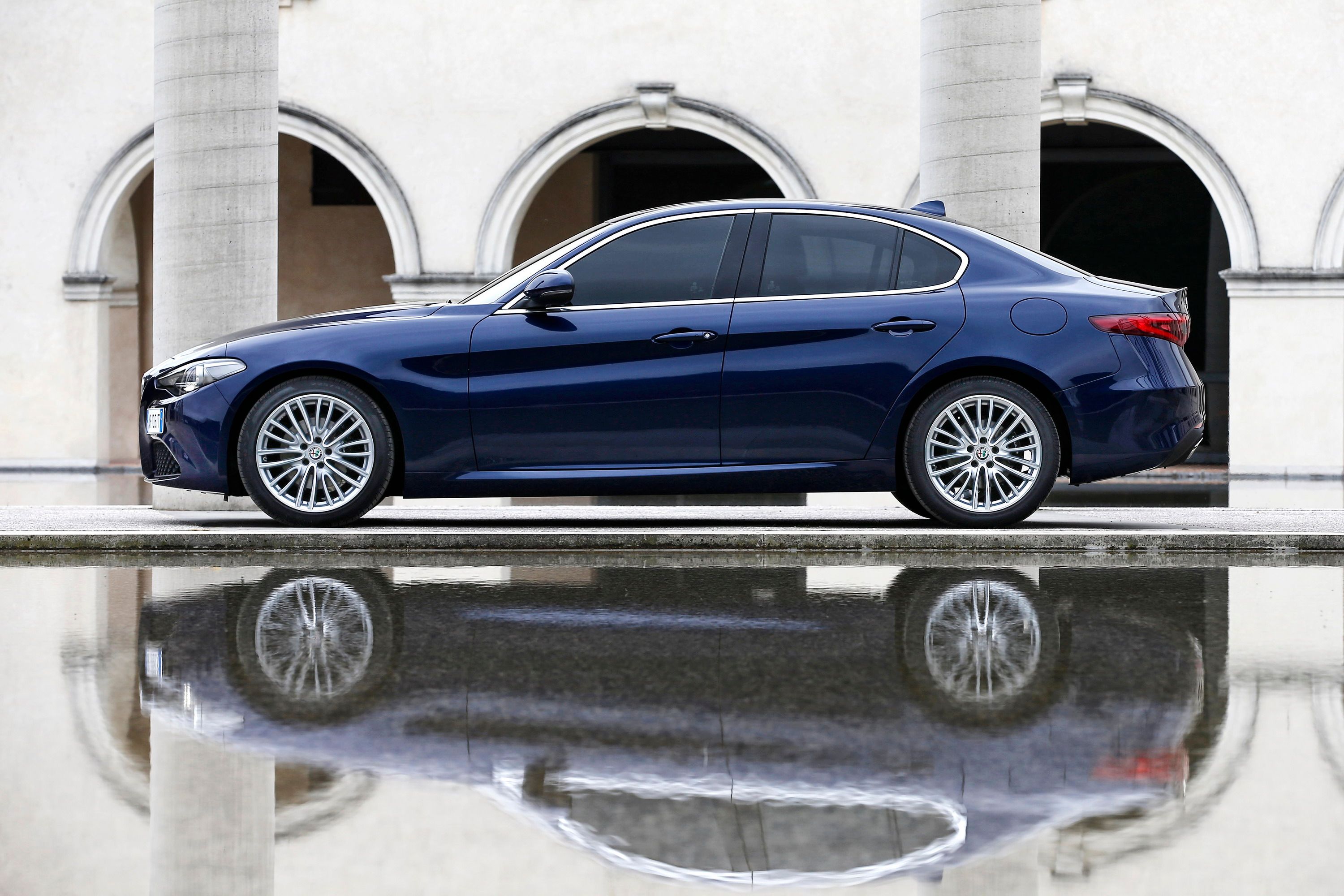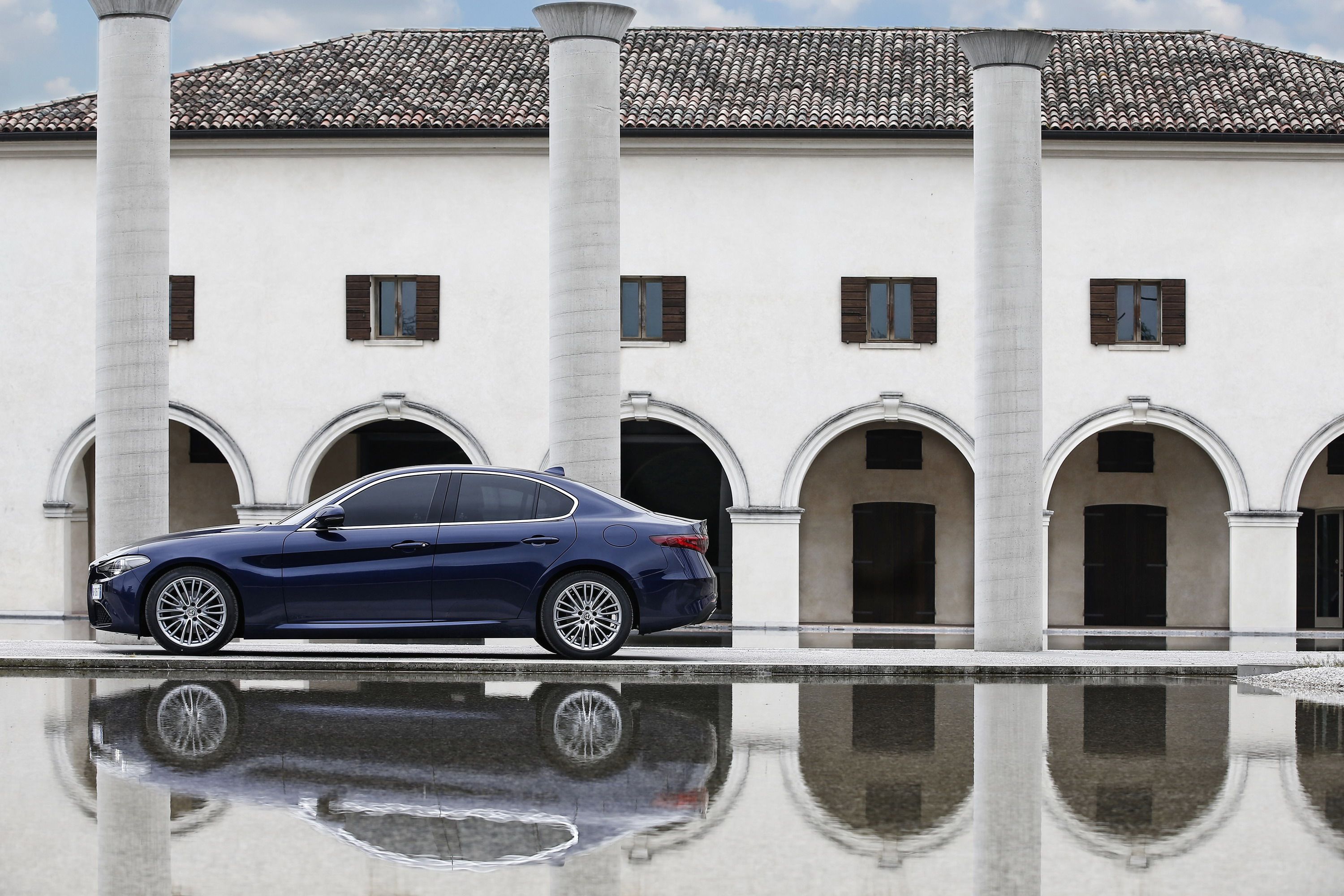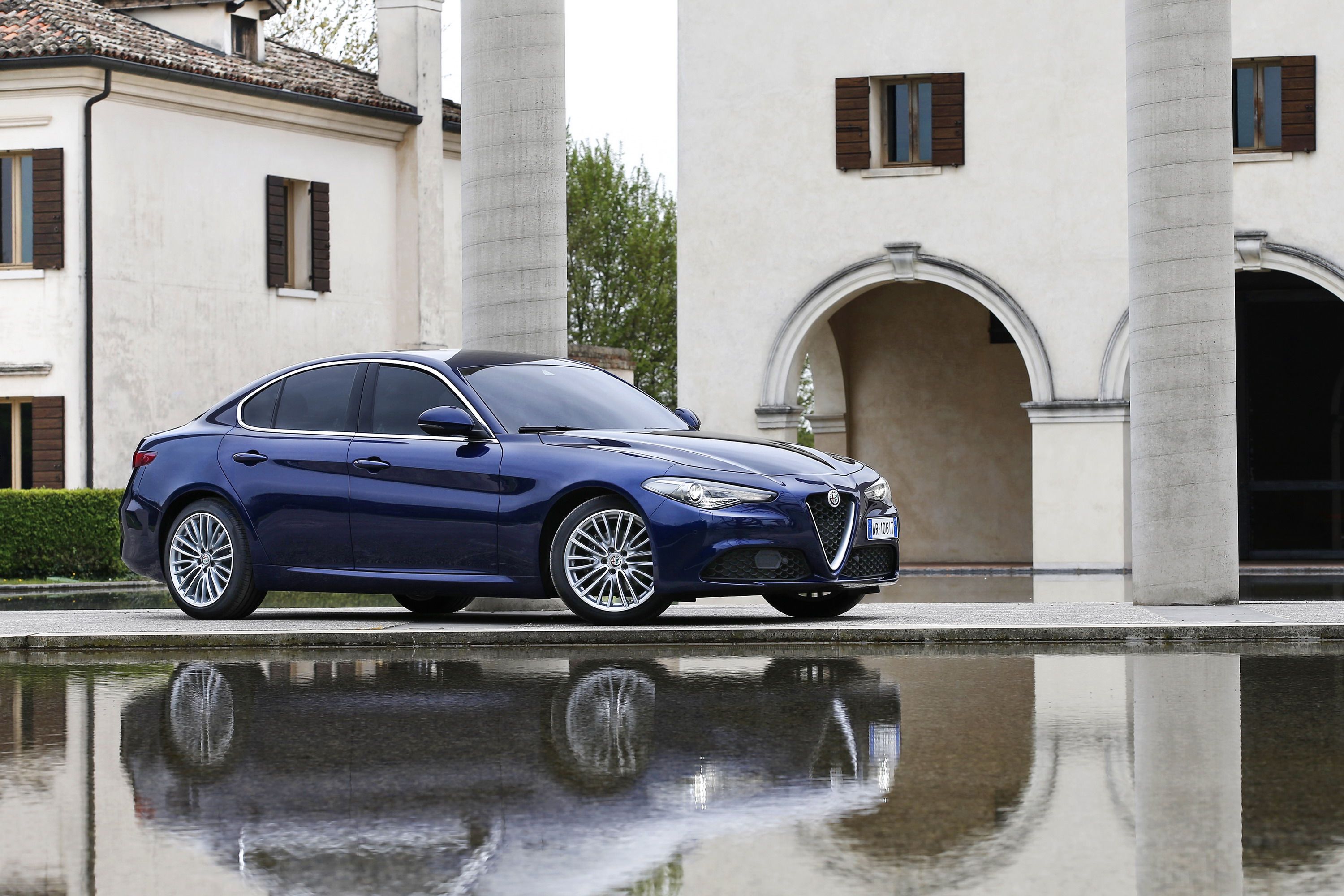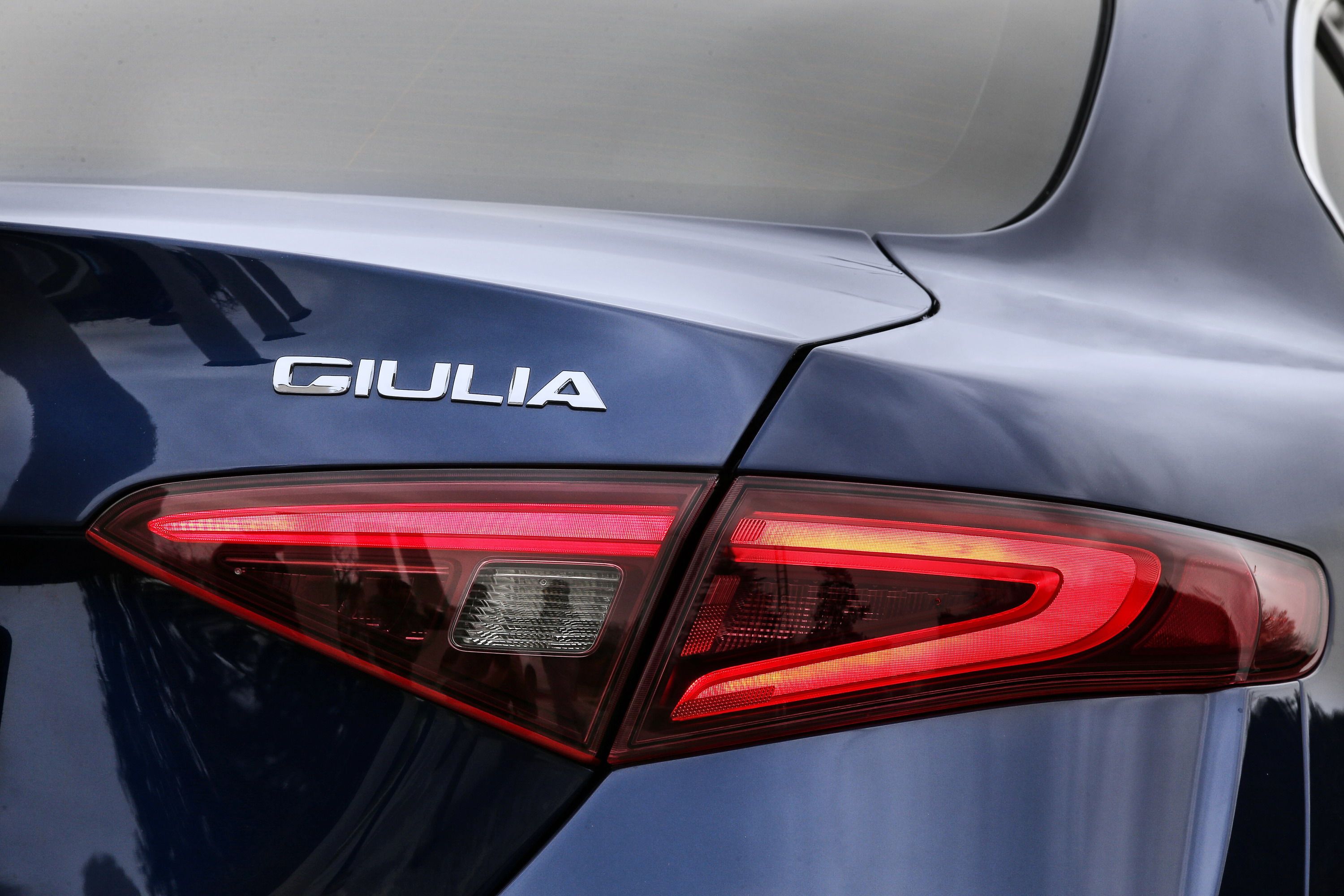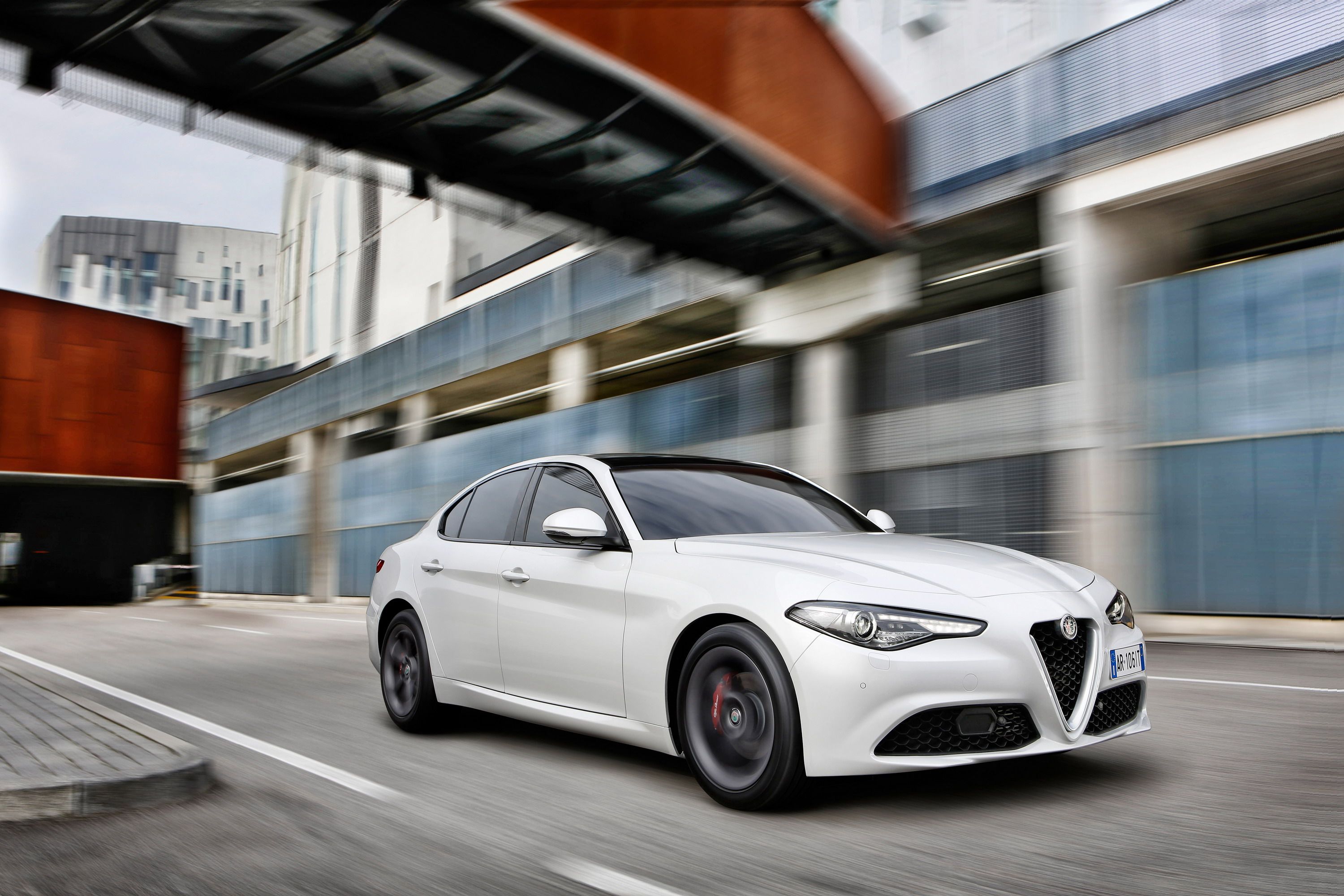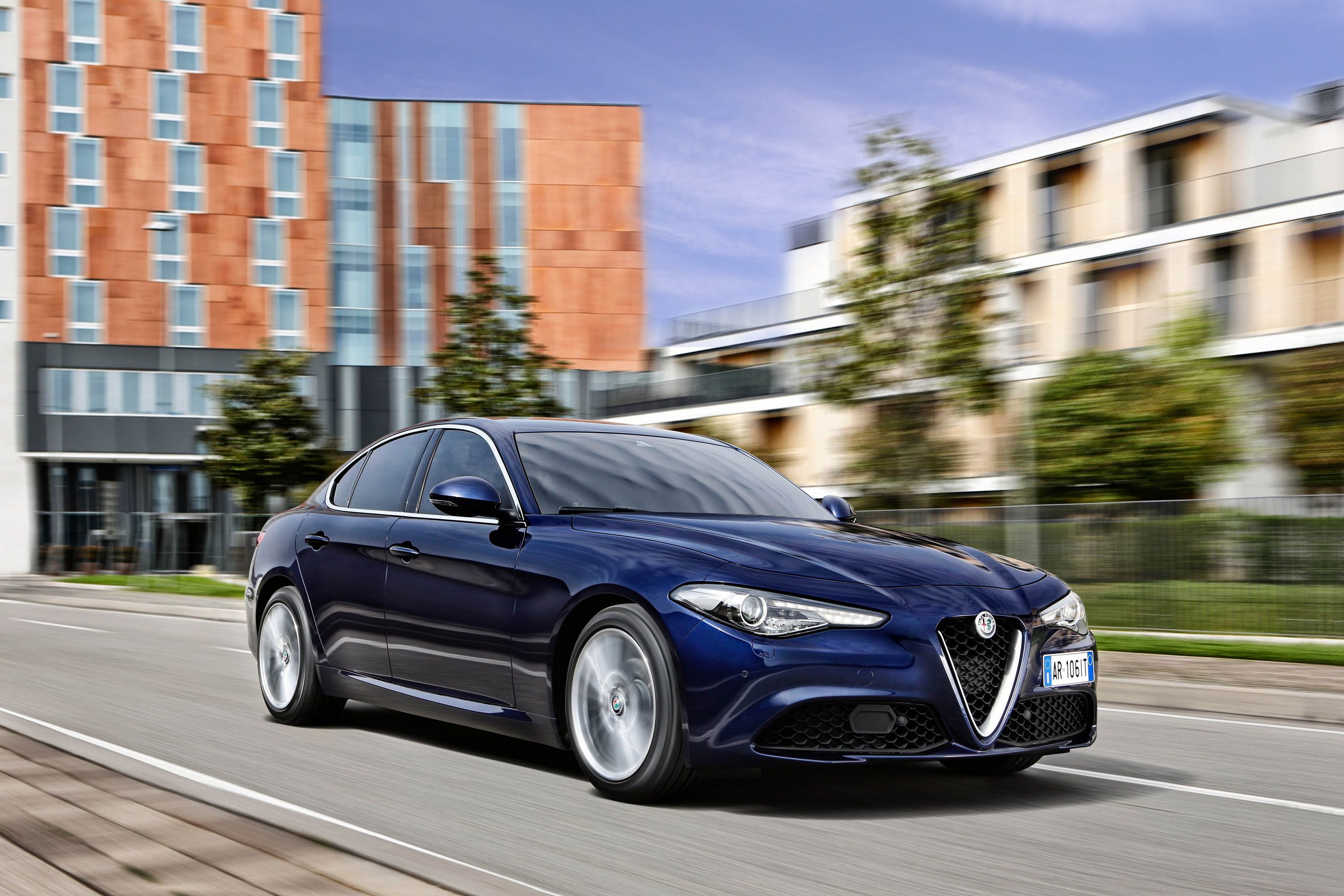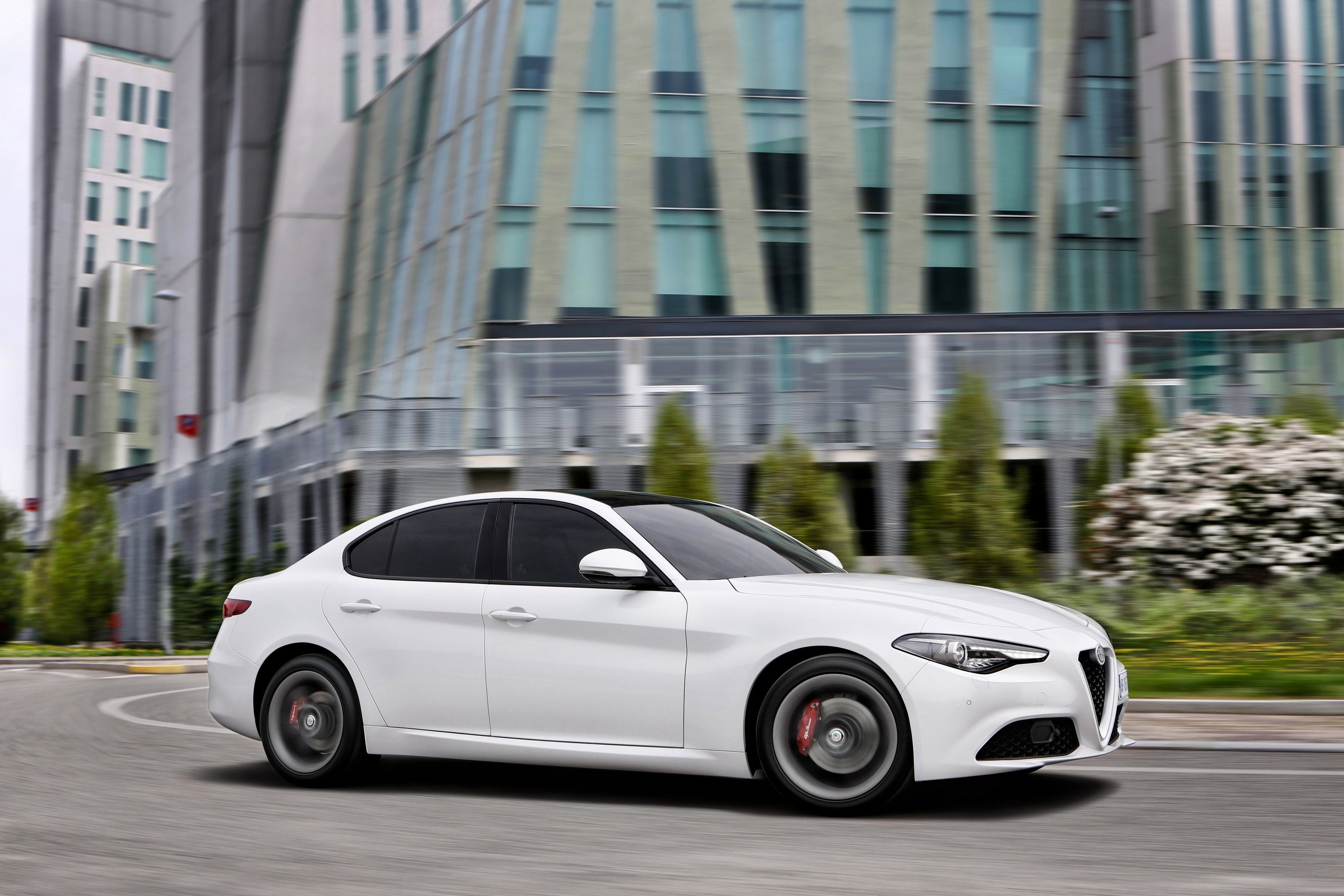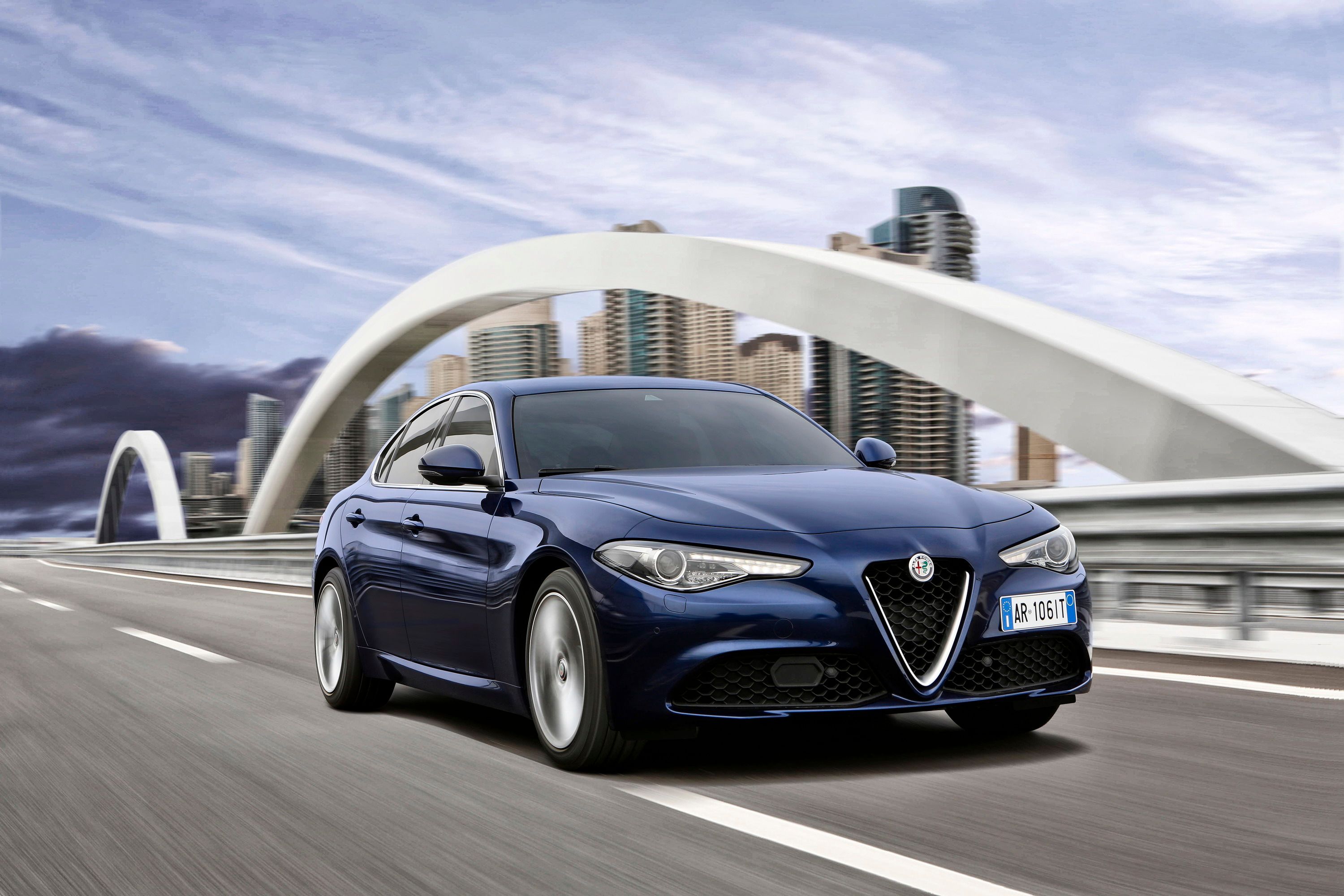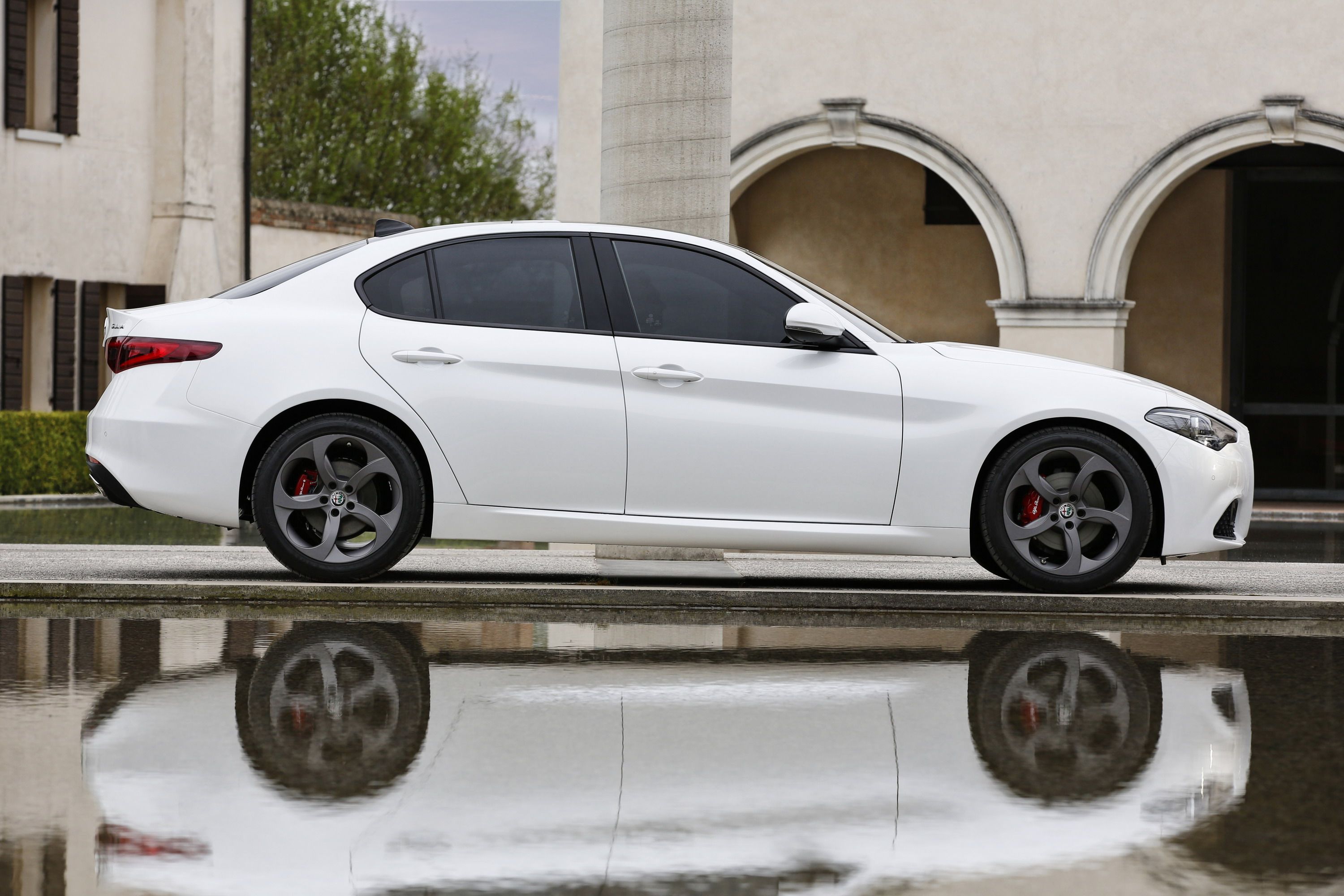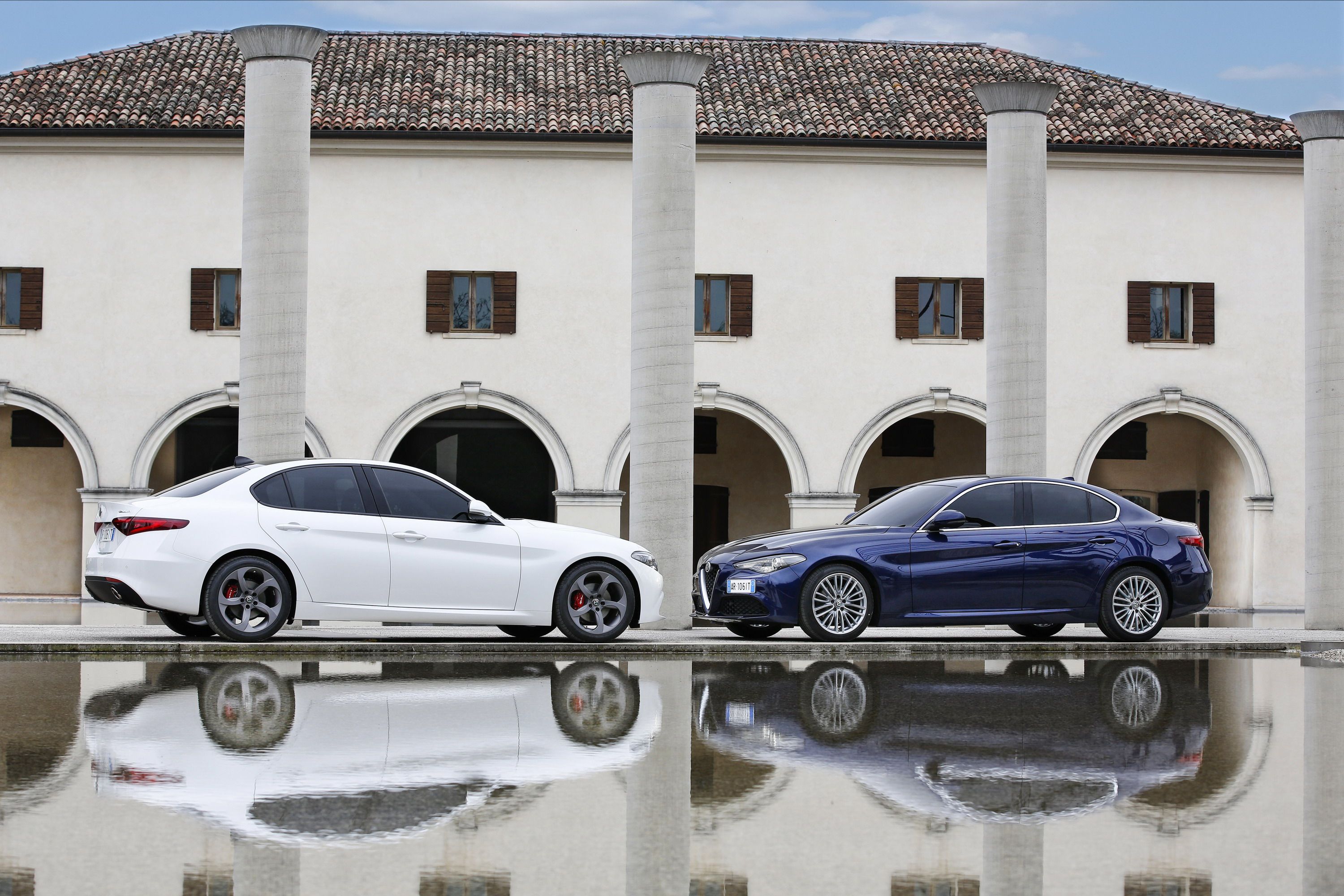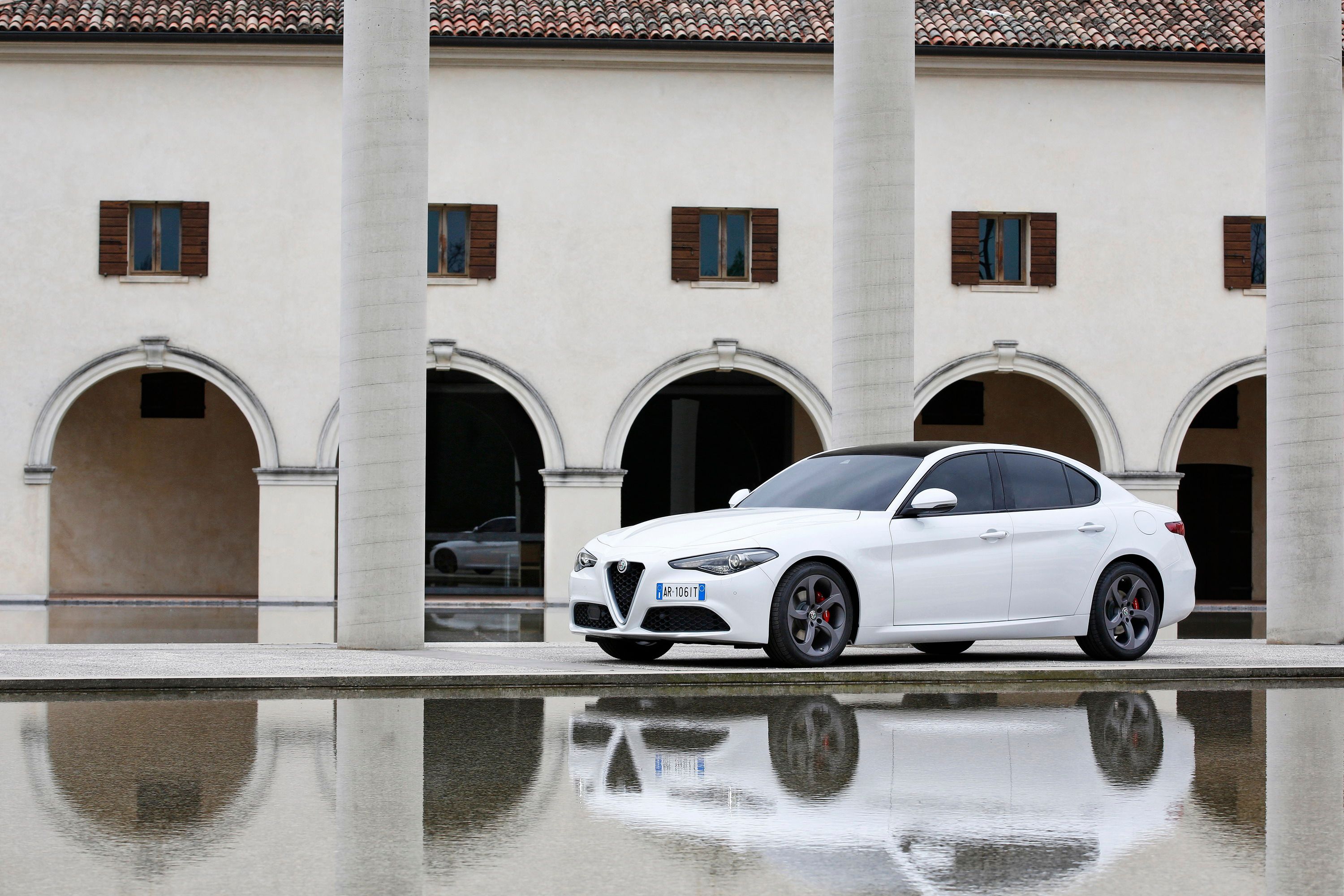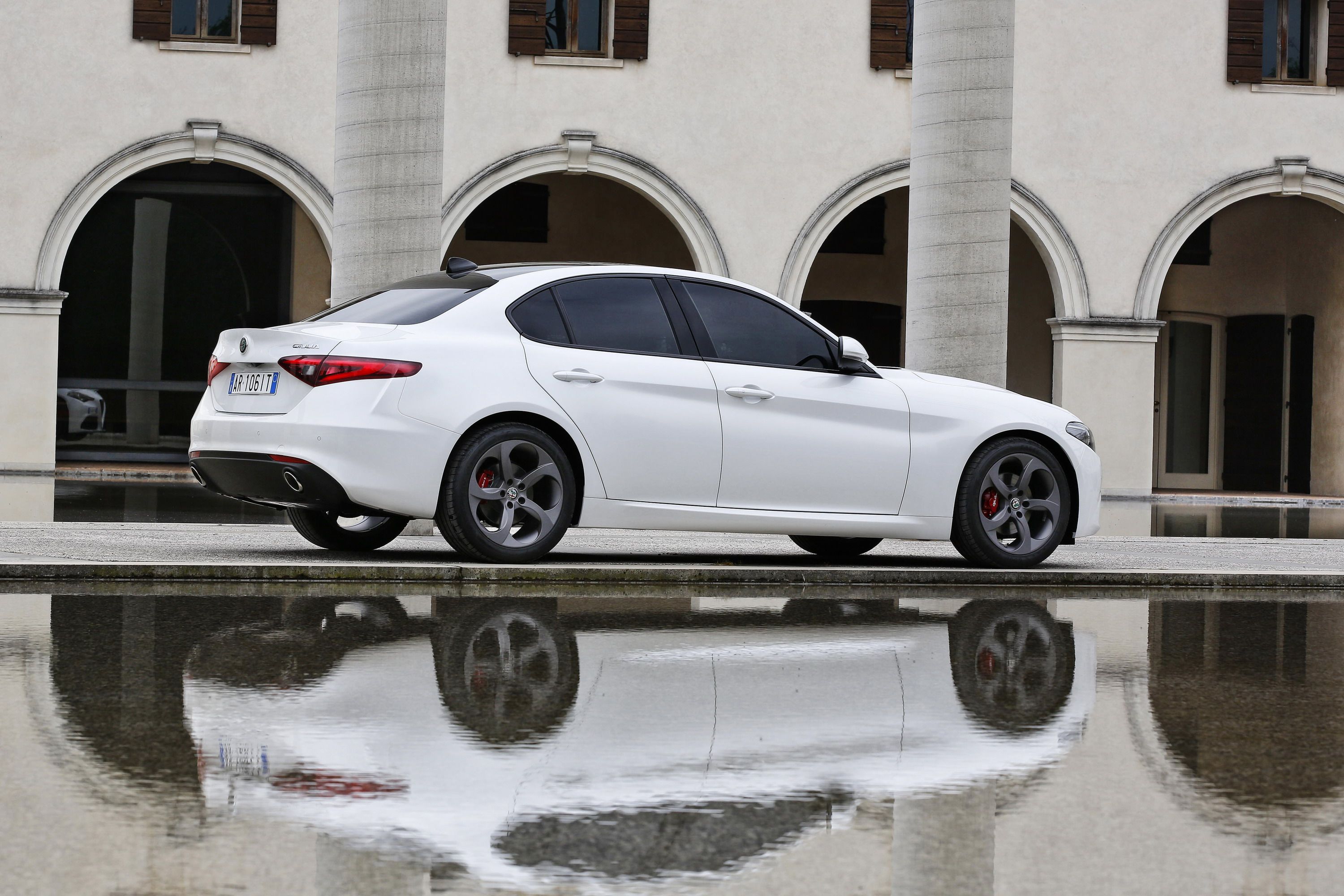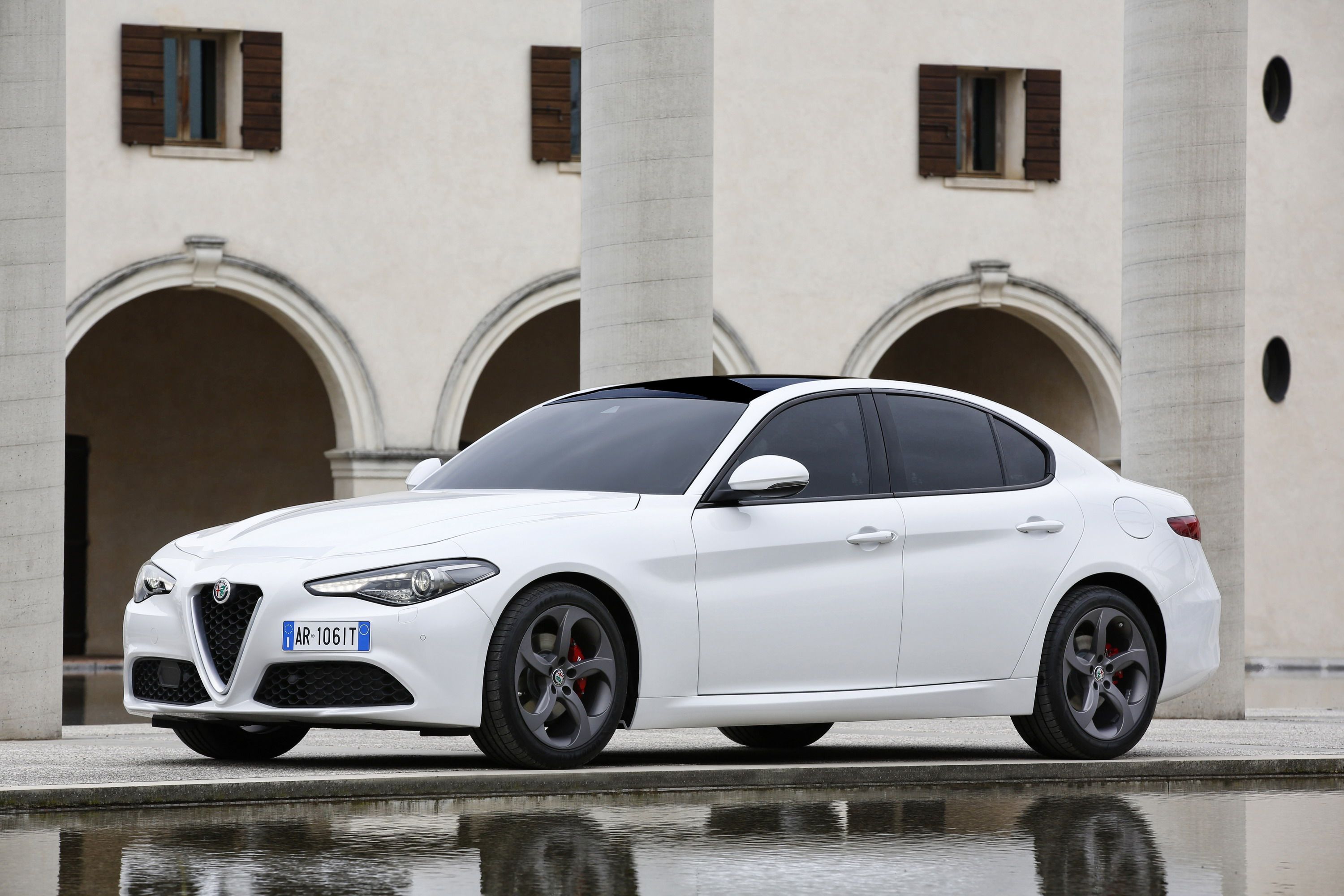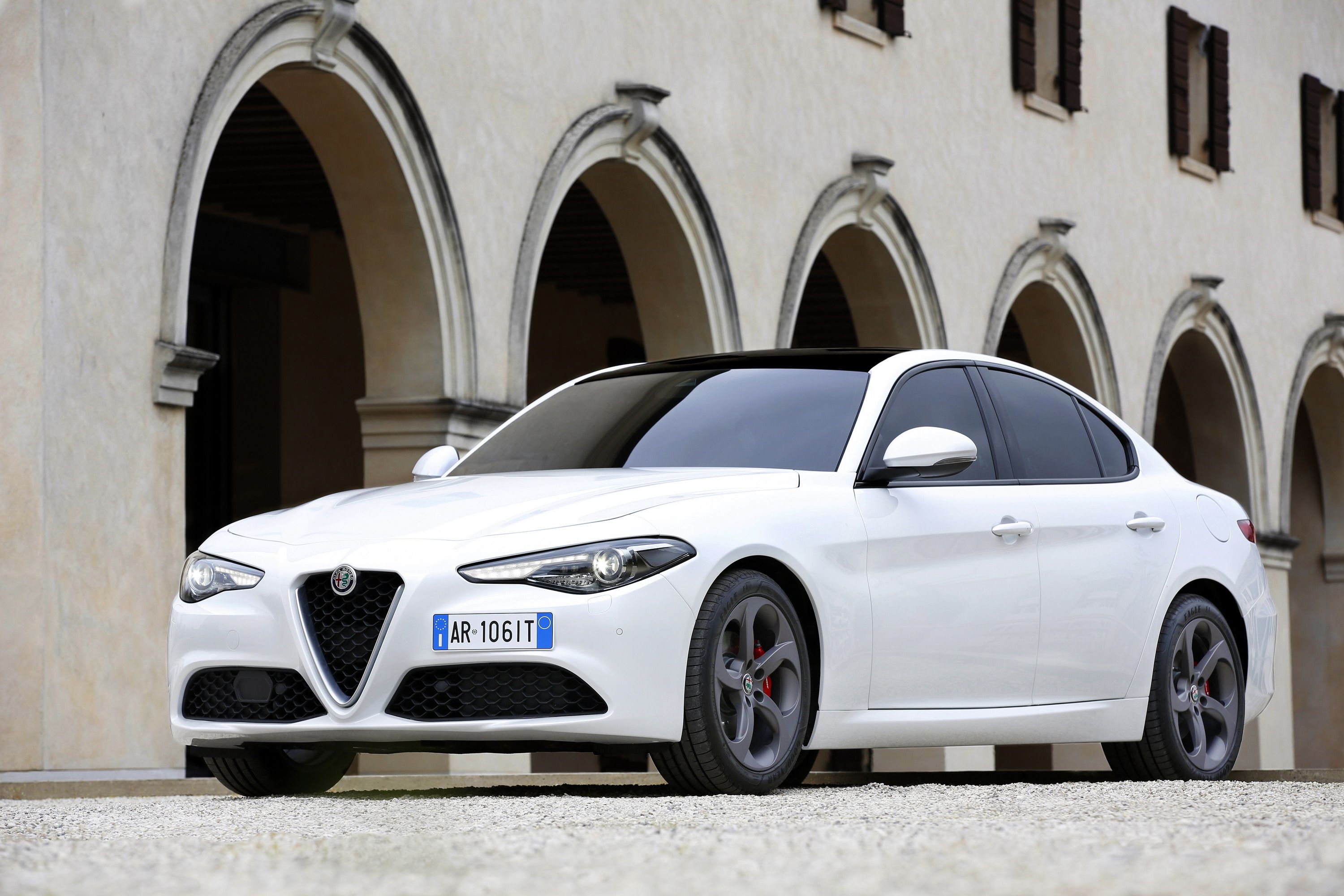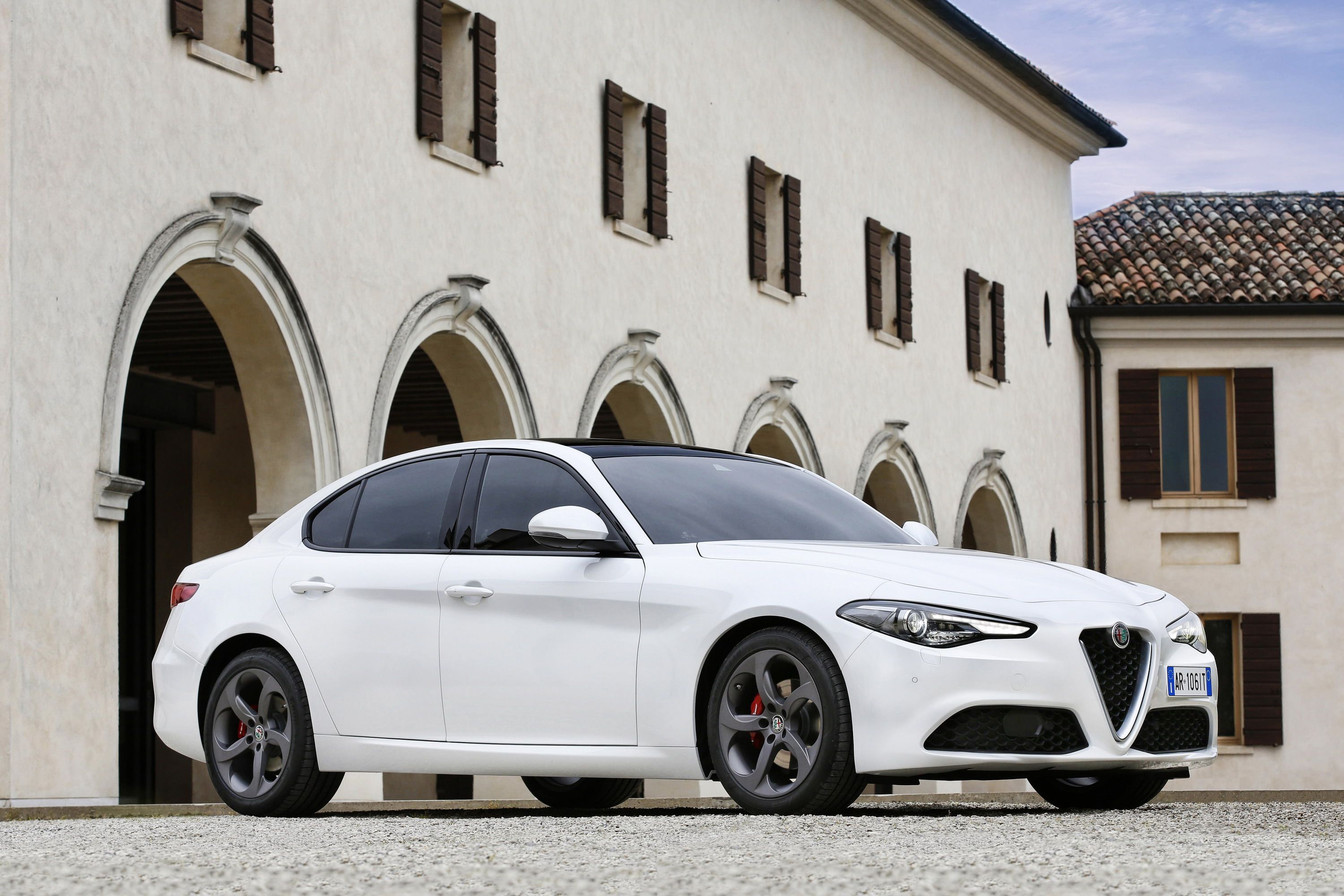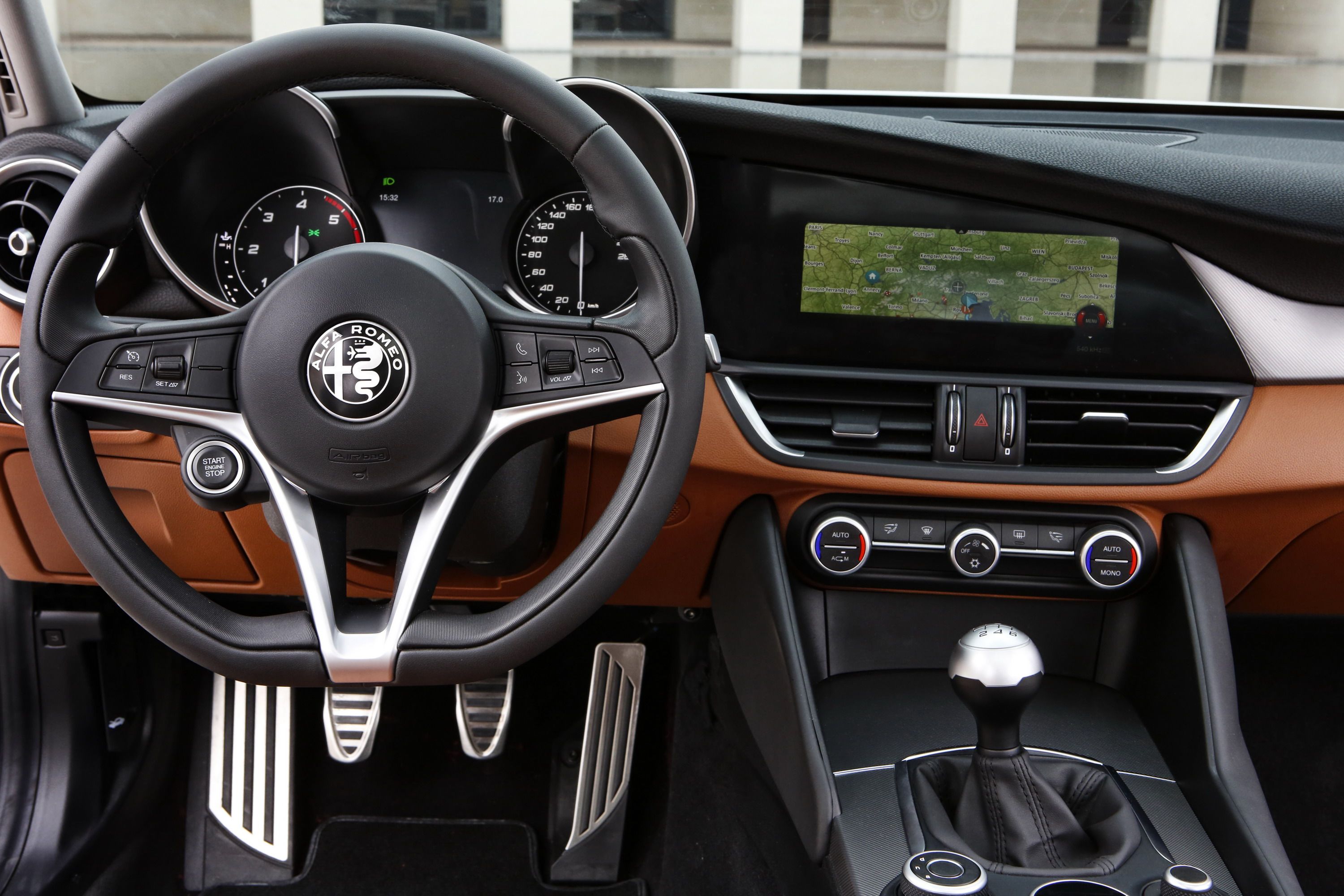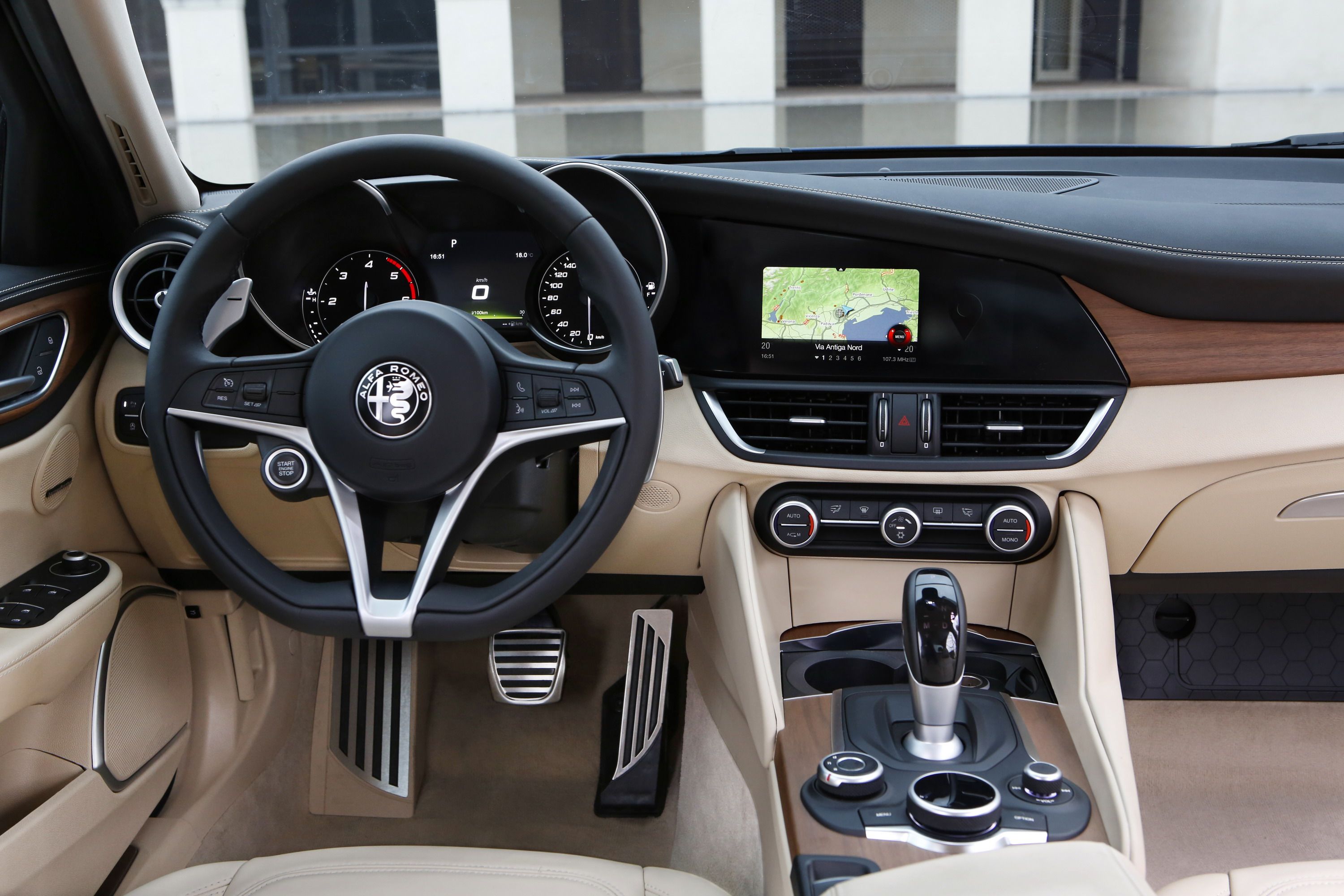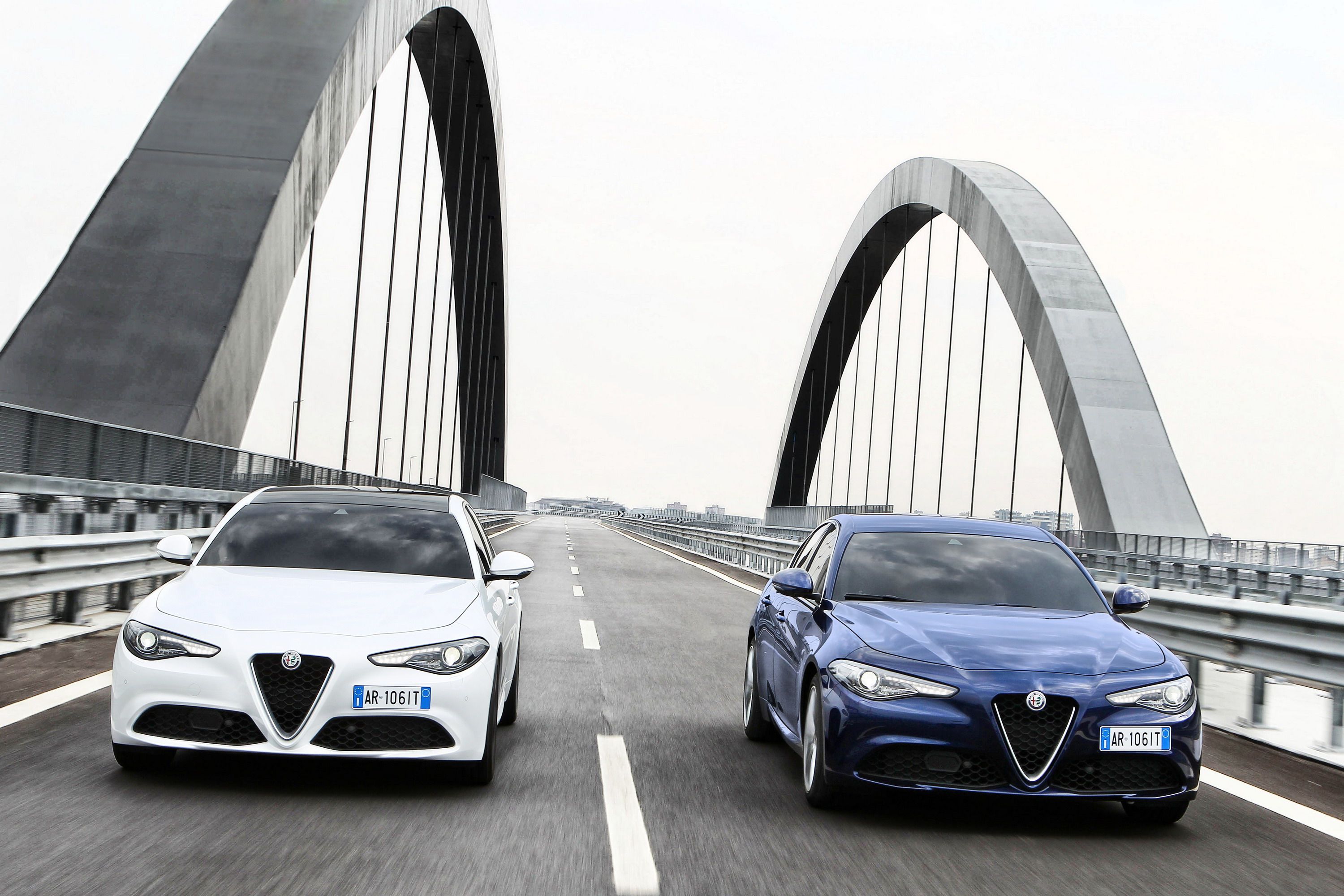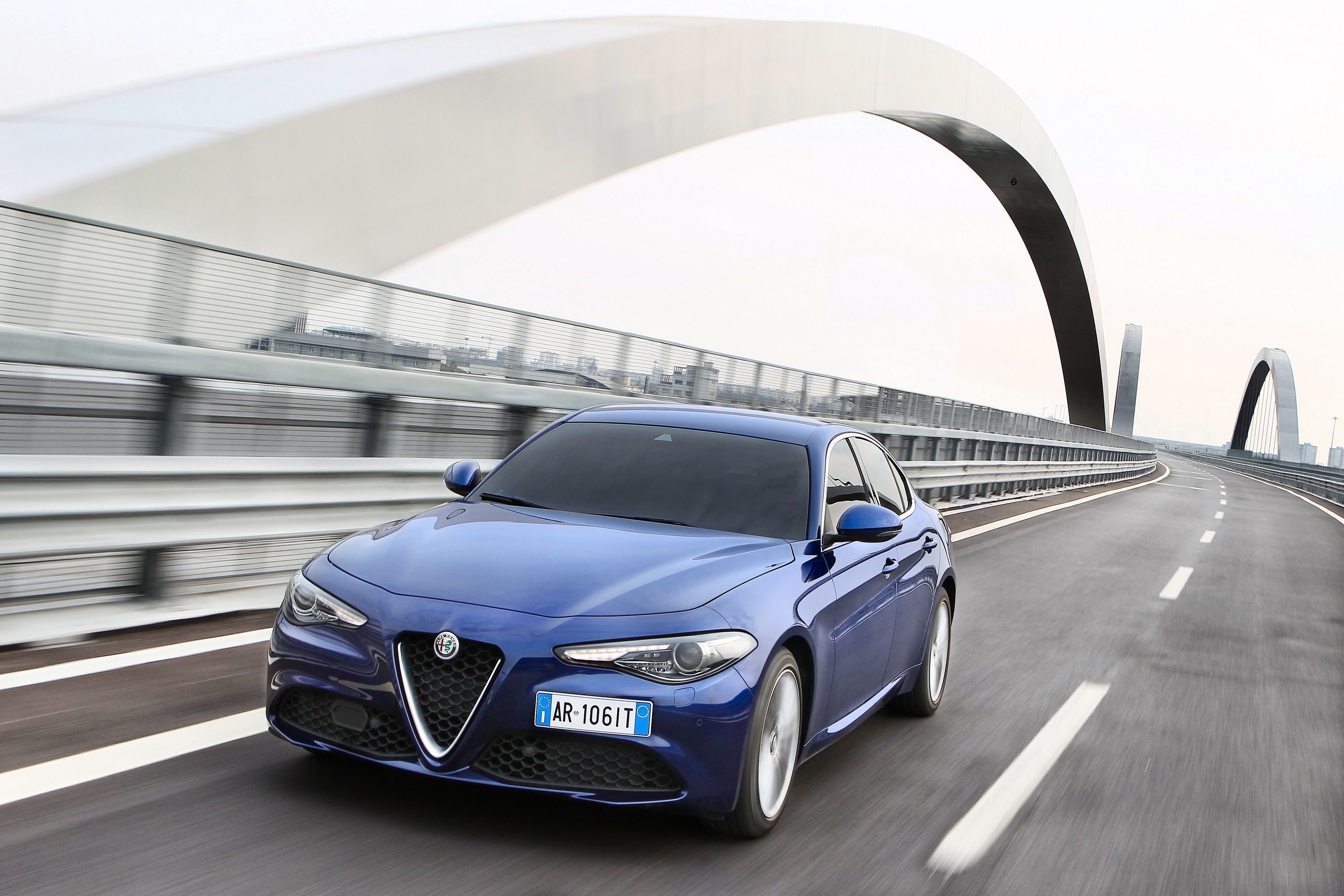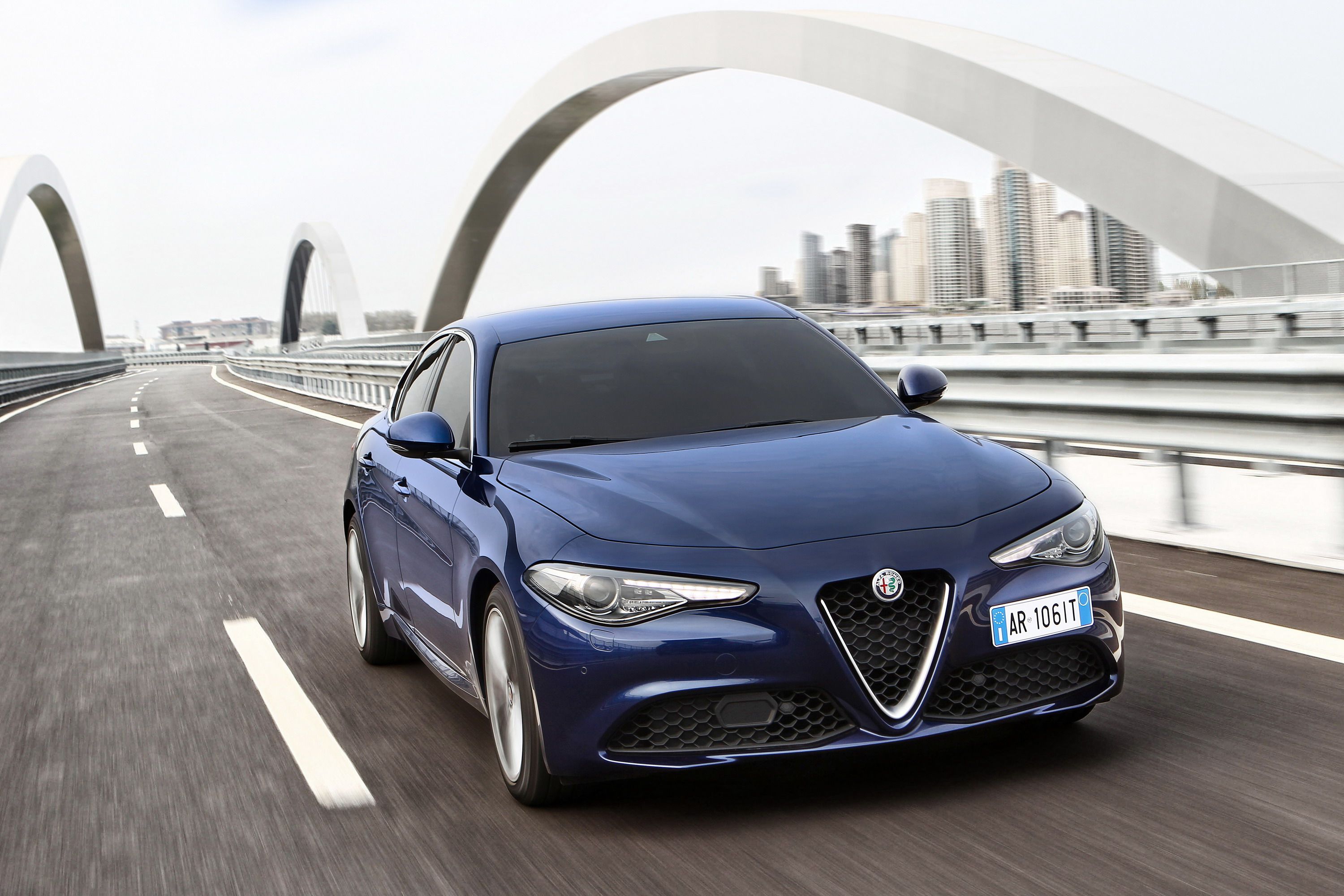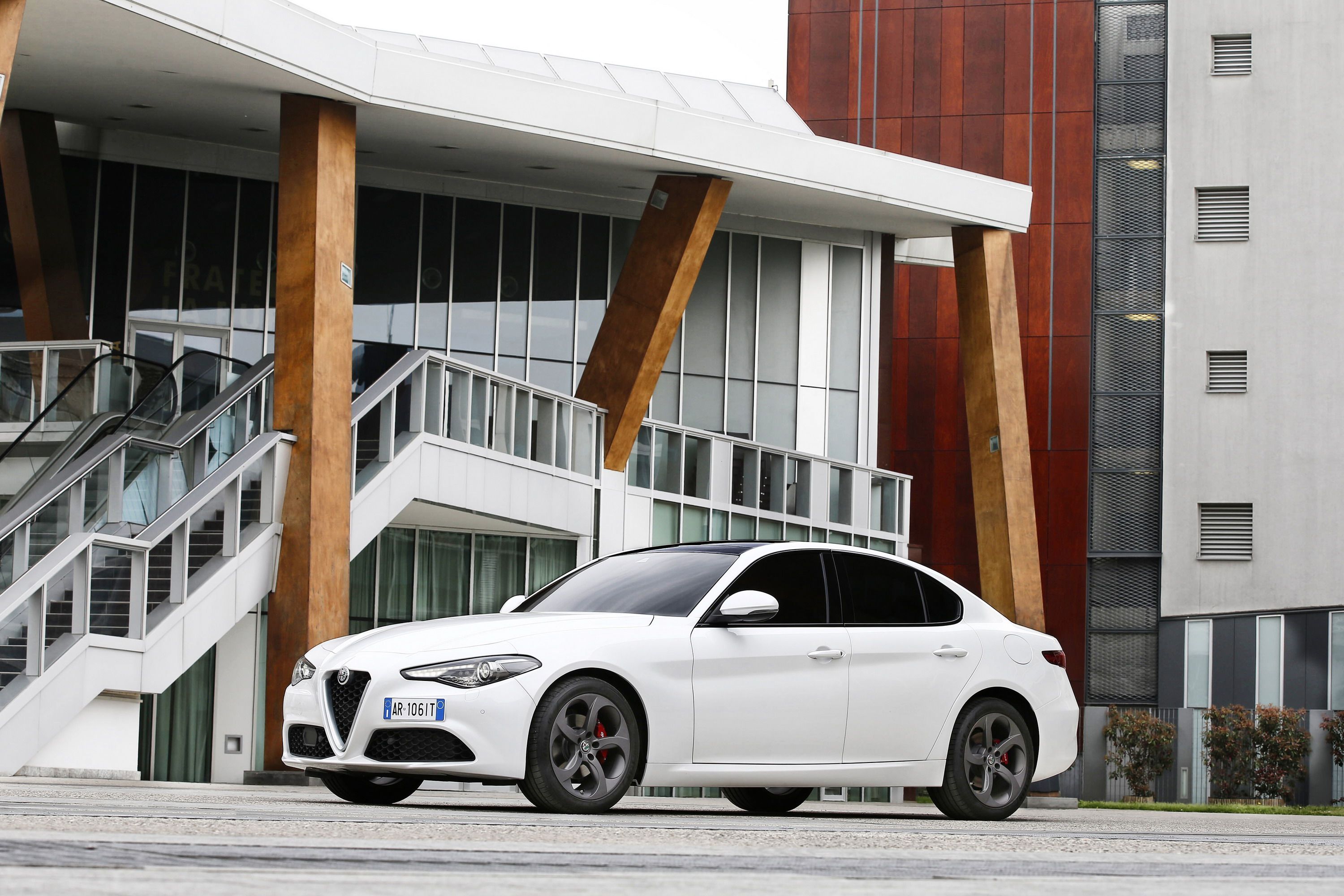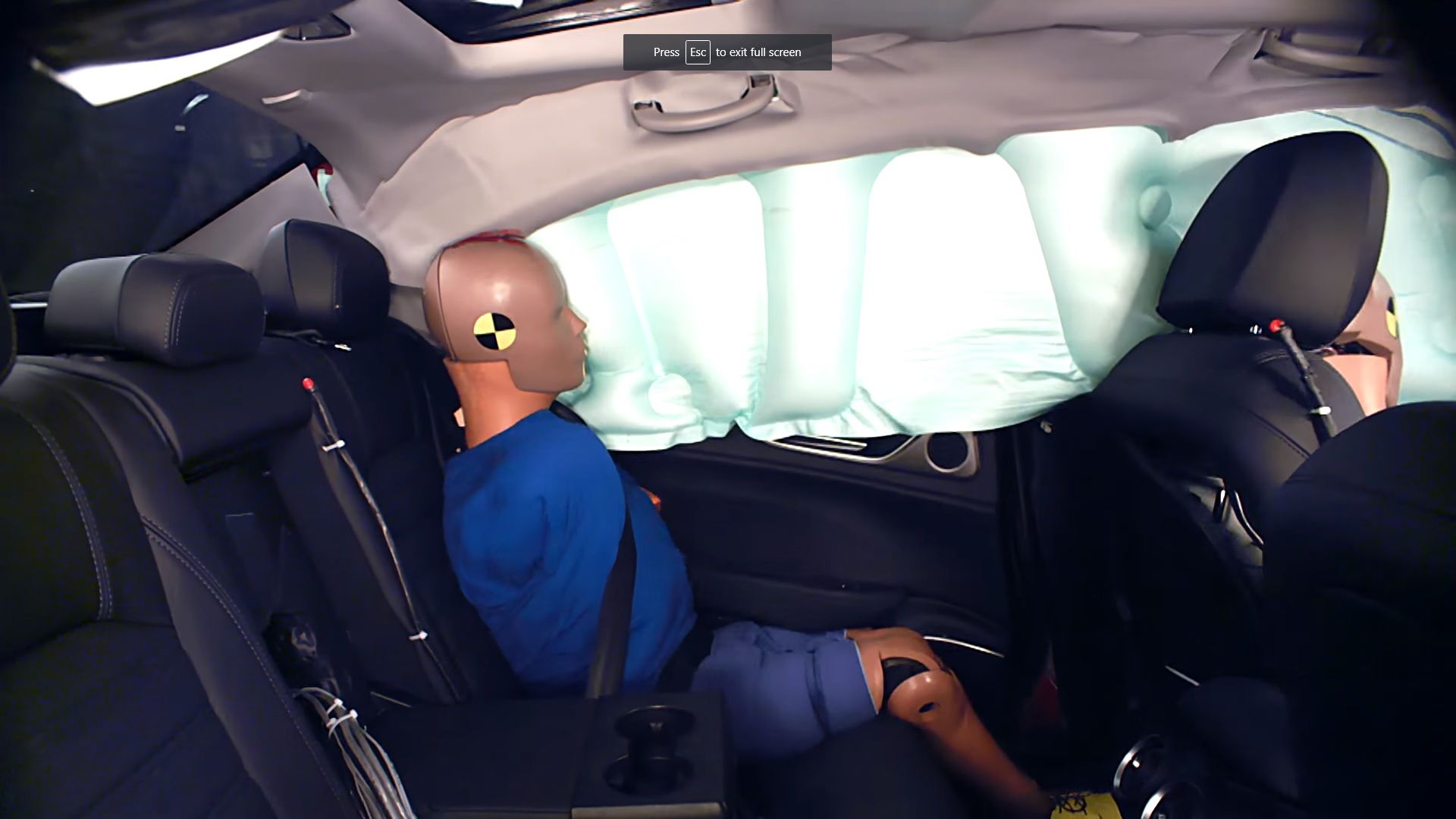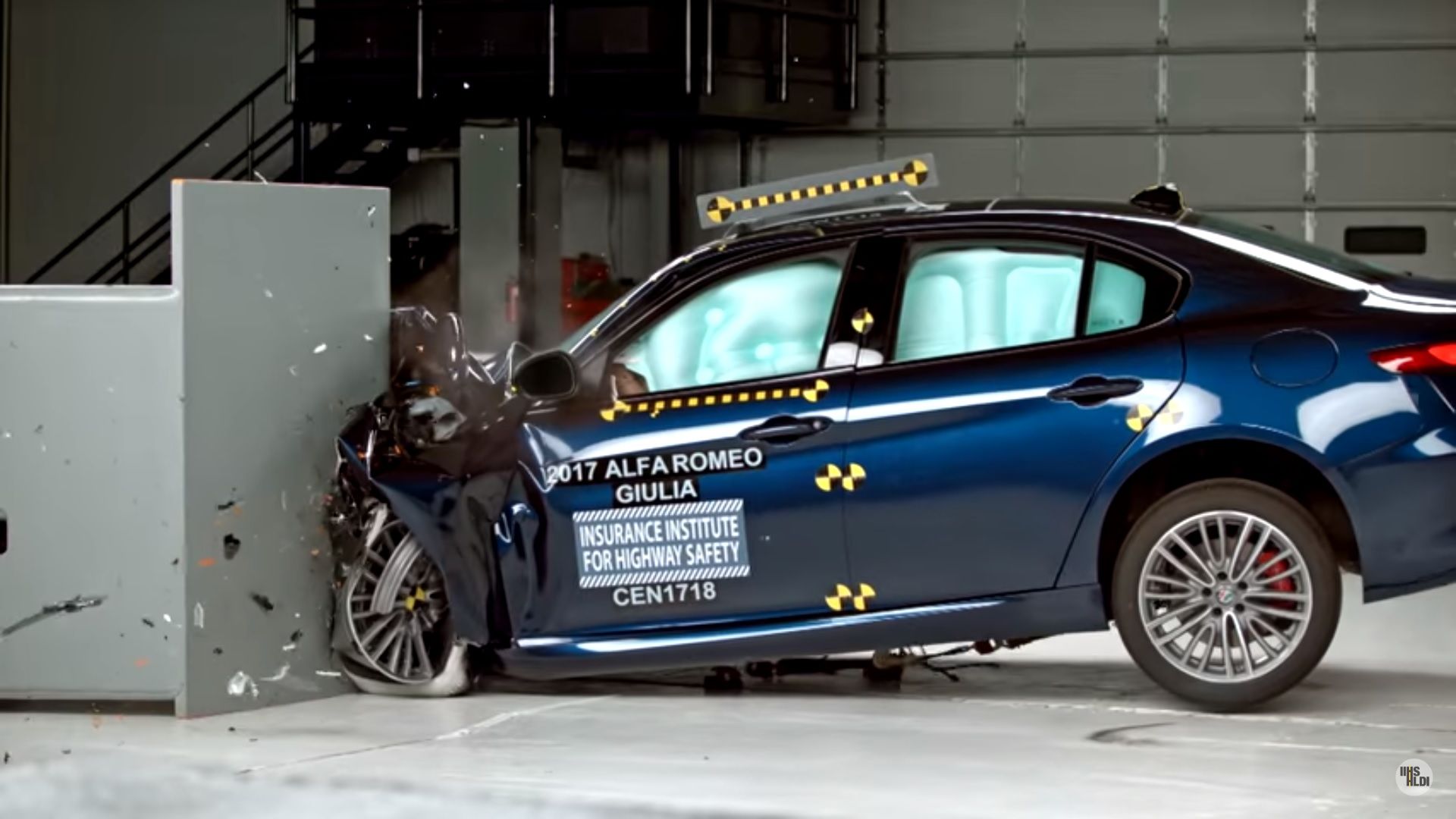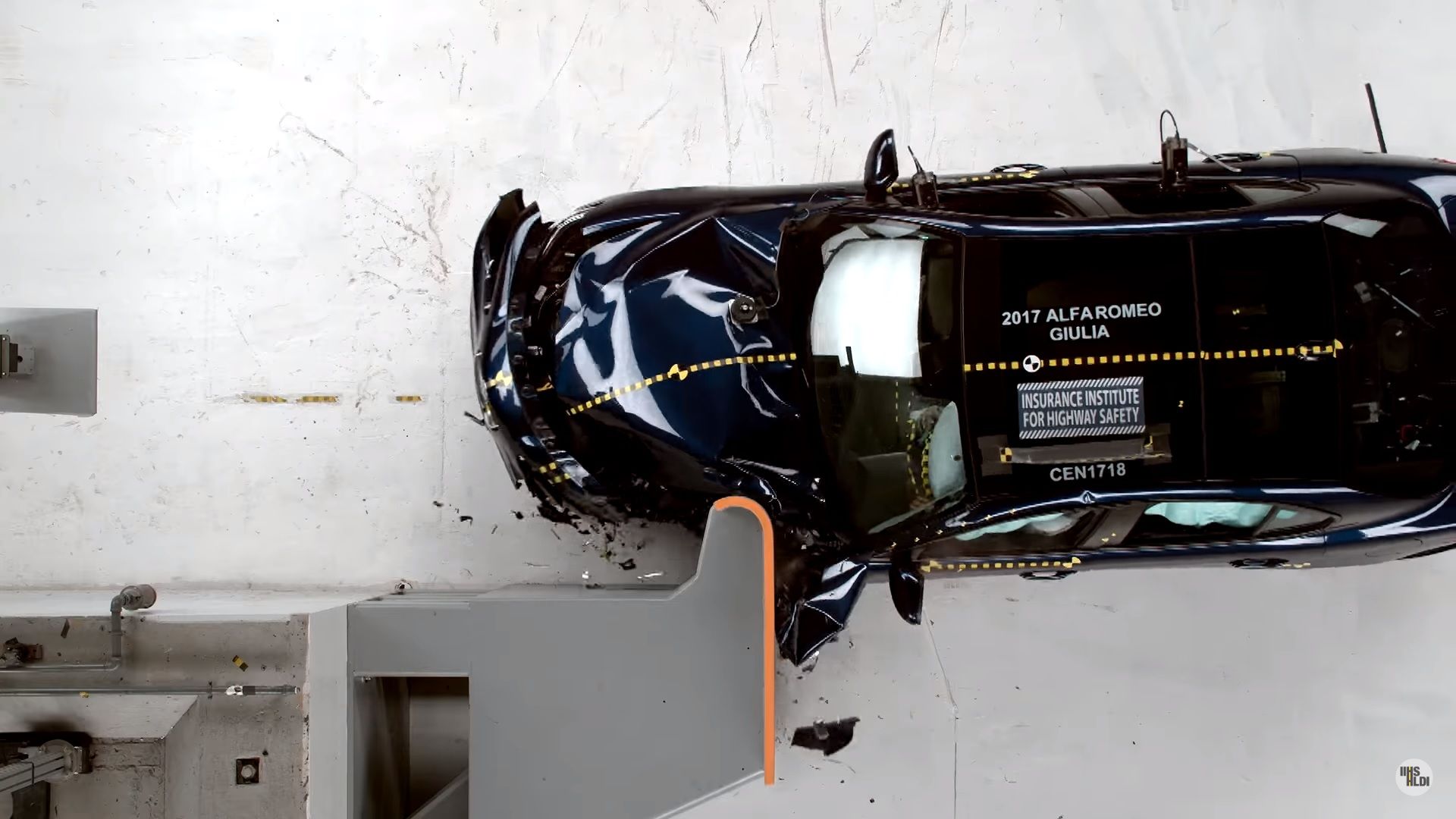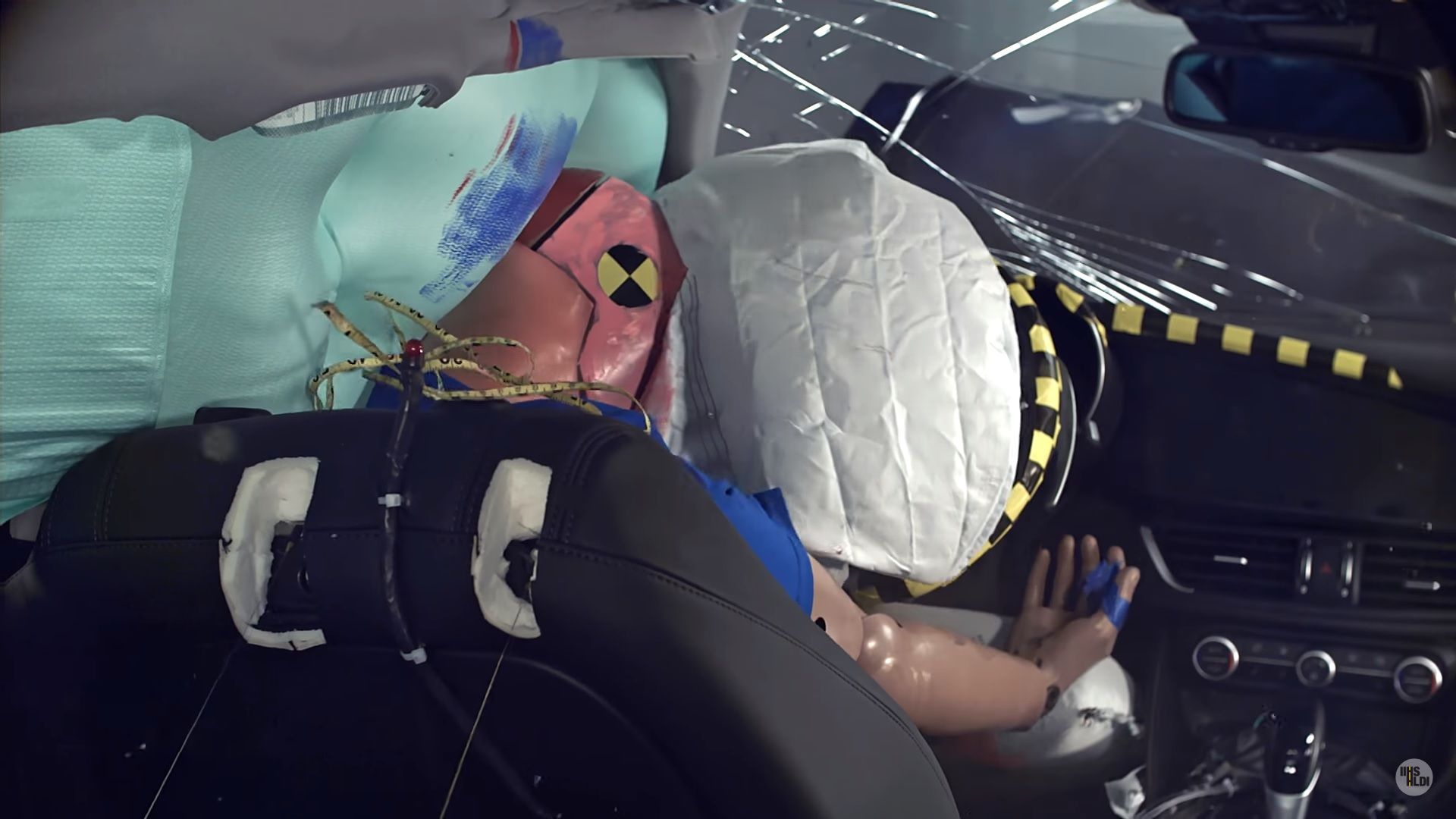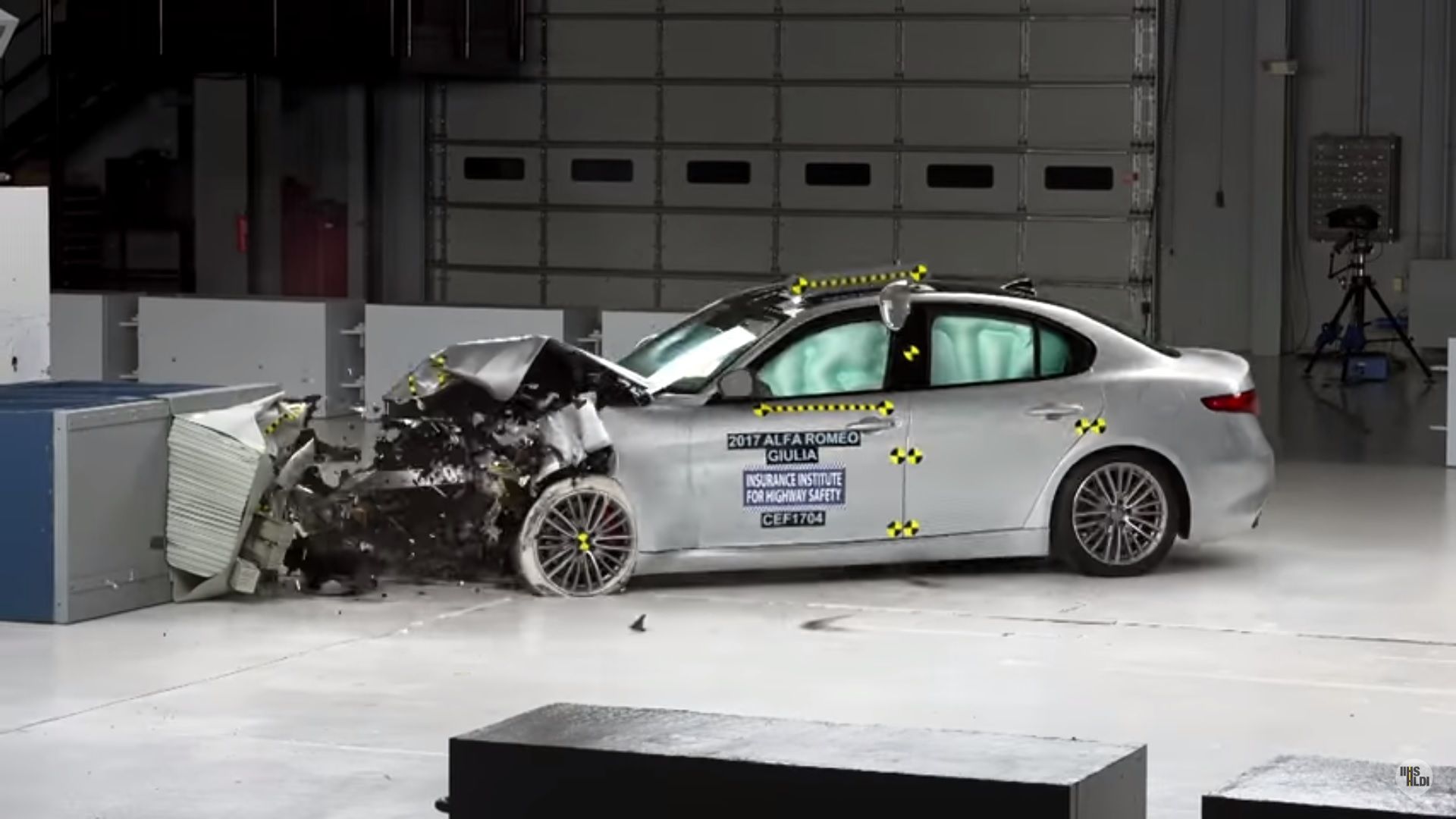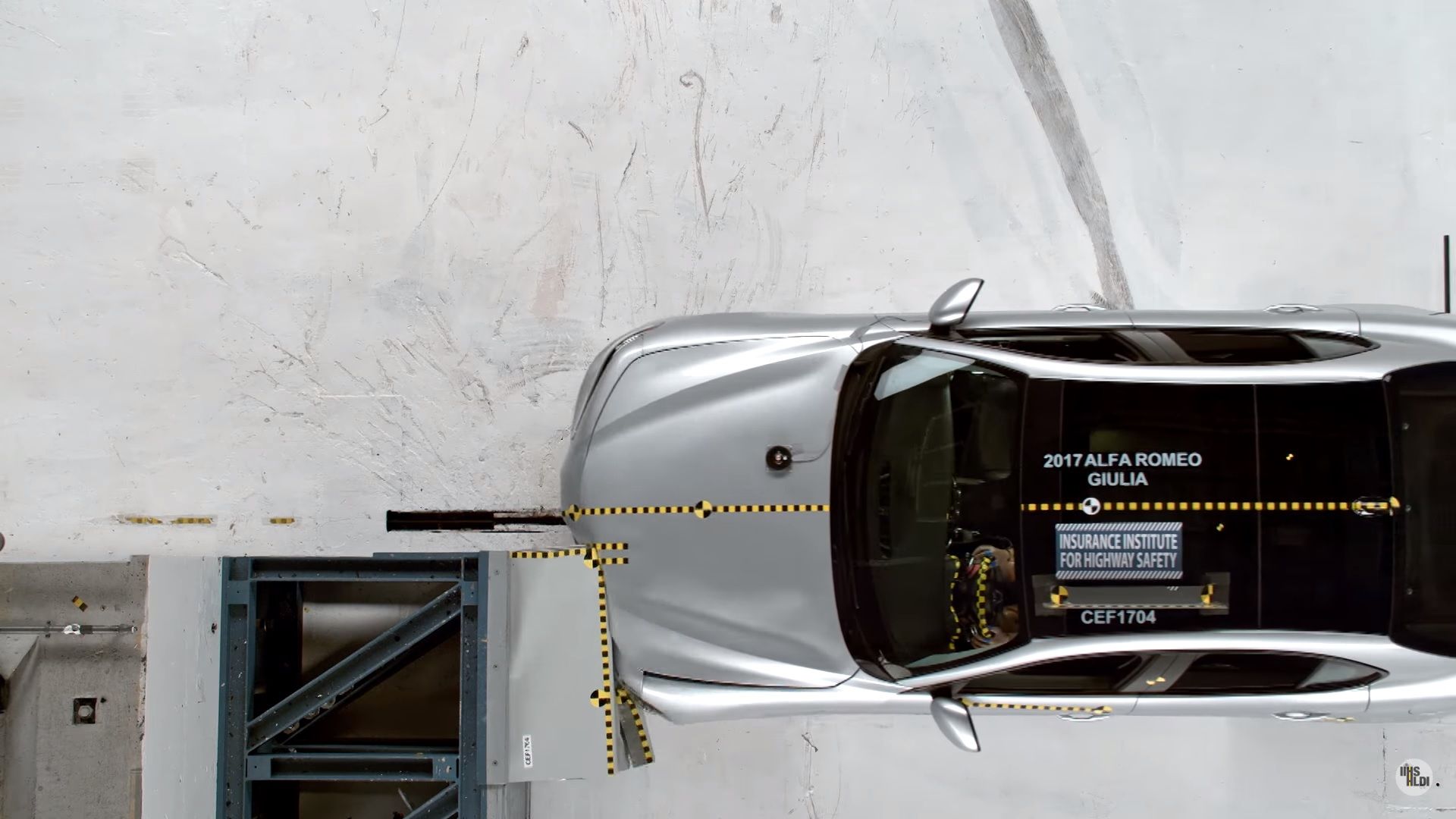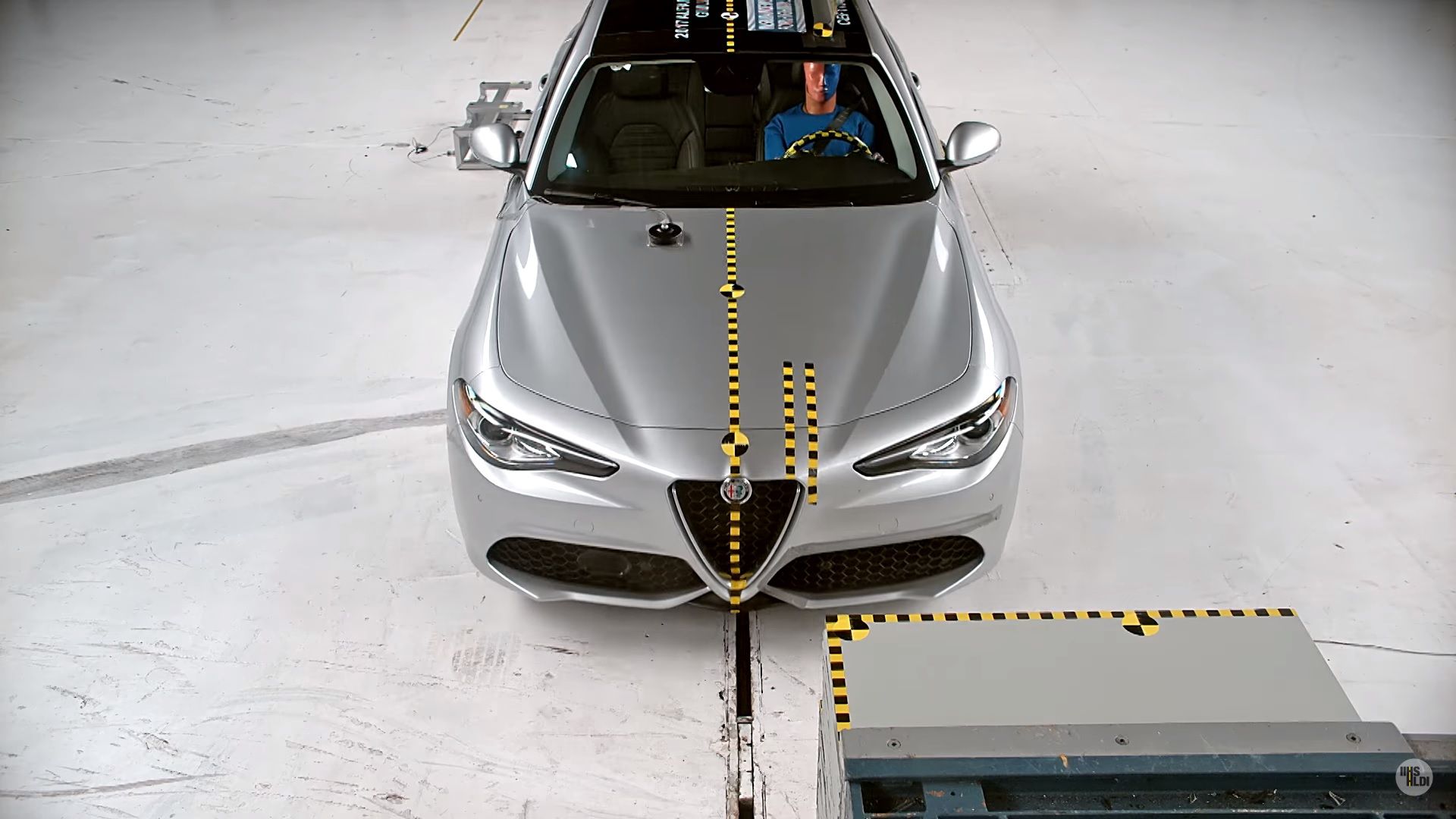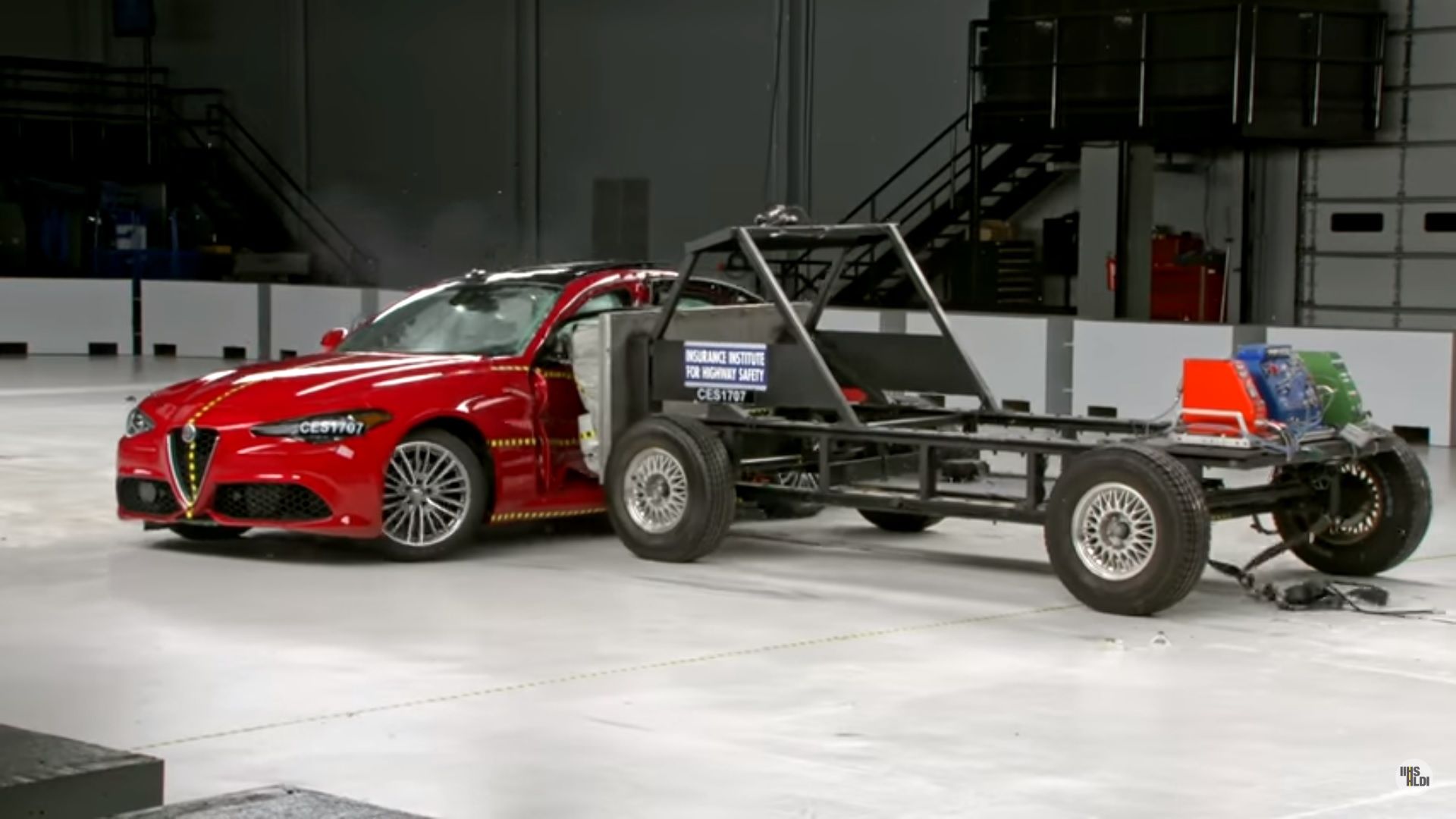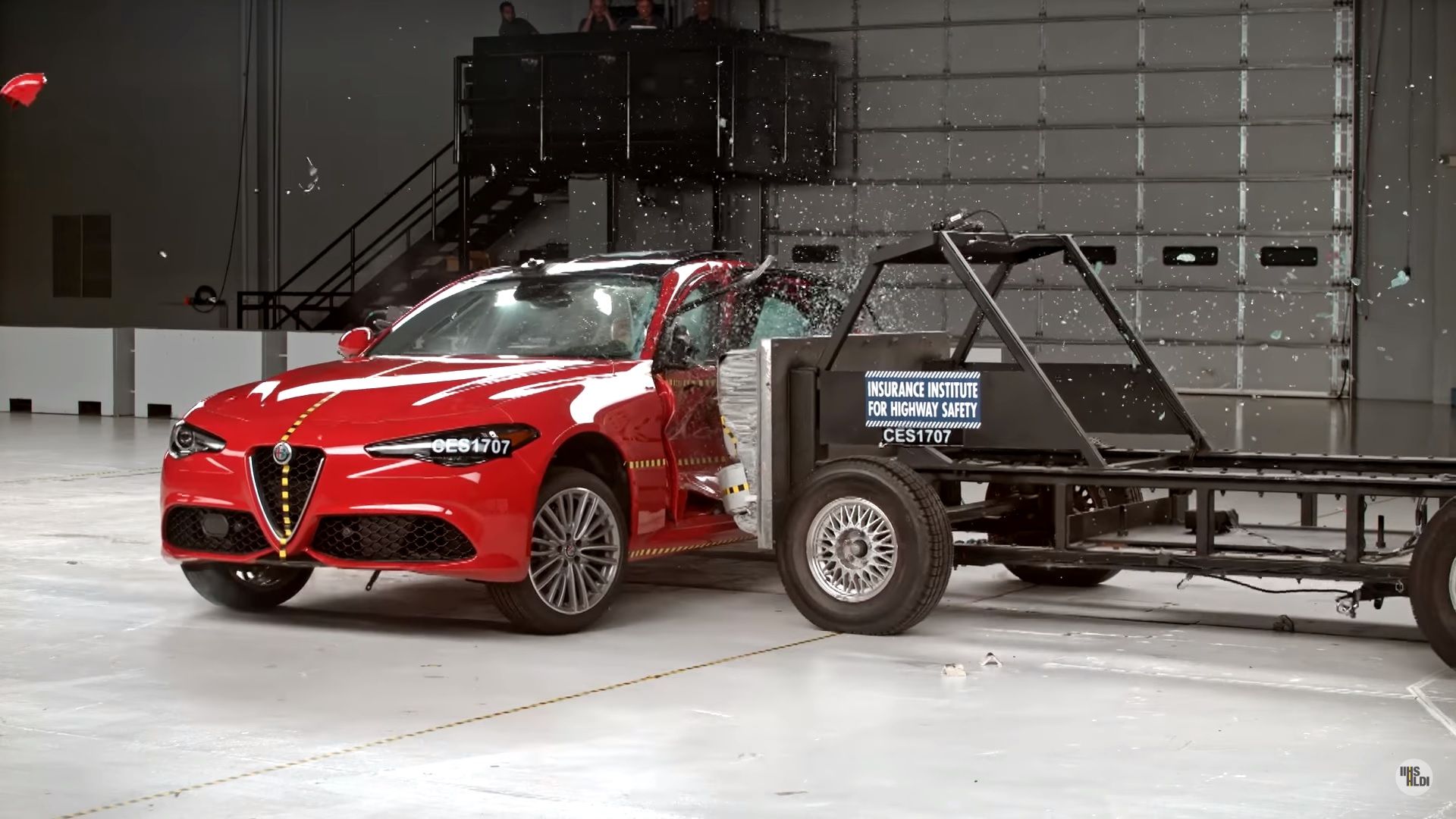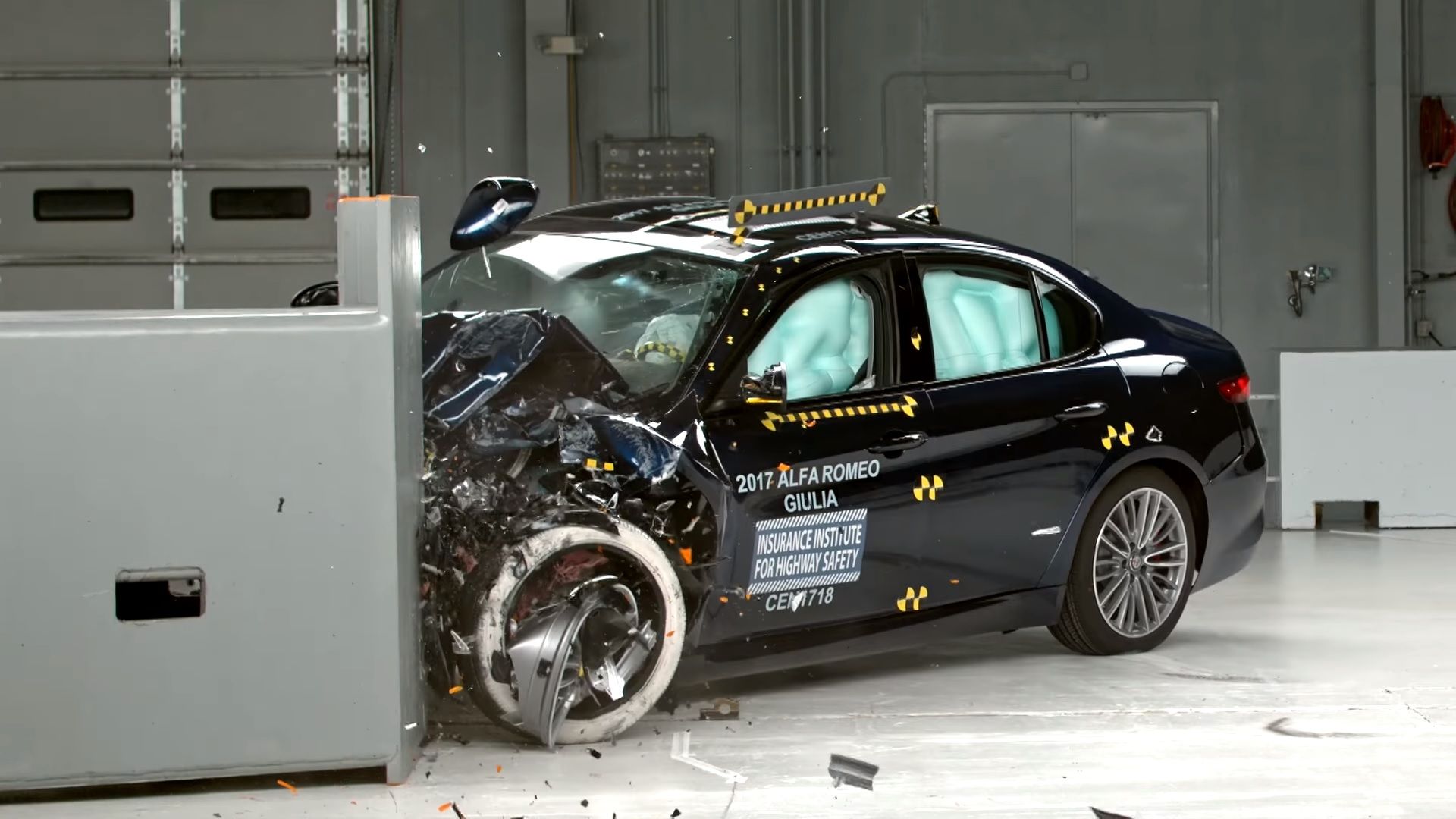Alfa Romeo did work backward when it came to the new Giulia Sedan. It threw its top performer, the Giulia Quadrifoglio into the mix first, showcasing its beautiful looks and 505-horsepower, 2.9-liter twin-turbo V-6. But, there’s more to the Giulia than that. See, the Giulia is sort of like Alfa Romeo’s rebirth here in America, kicking off the introduction of several all-new models that will join the tiny, but fun 4C Coupe and 4C Spider. Alfa didn’t waste any time debuting the rest of the Giulia lineup, which means you don’t have to pay for the range-topping model unless you really want to. Outside of the Quadrifoglio model, the Giulia is available in two other guises: the entry-level model and the Giulia Ti. As far as the non-Quadrifoglio versions go, you get a 2.0-liter, turbocharged, four-cylinder that delivers a cool 280 horsepower and 206 pound-feet of torque. Other standard features include a seven-inch infotainment system, LED exterior lighting, dual exhaust, and can be had with all-wheel drive for a small premium.
The Giulia is set to go on sale here in the U.S. for the 2017 model year and is focused around the driver. Reid Bigland, the Head of Alfa Romeo, said, The all-new Giulia is the result of our 105 years of passion for Italian style, craftsmanship, and performance. Crafted in Italy, the Giulia lineup sets an entirely new benchmark for the segment as the world’s fastest four-door production sedan, featuring class-leading engines, an all-new exclusive architecture, stunning design and state-of-the-art technology.”
And, he’s absolutely right. This is one of those cars that is clearly living up to the hype created over the past couple of years. It’s affordable, stylish, and ready to take on the competition. But, before we get too far ahead of ourselves, let’s have a better look at the new Alfa Romeo Giulia.
Continue reading to learn more about the 2017 Alfa Romeo Giulia.
2017 Alfa Romeo Giulia
- Make: Array
- Model: 2017 Alfa Romeo Giulia
- Engine/Motor: inline-4
- Horsepower: 200
- Torque: 243
- Transmission: eight-speed automatic
- [do not use] Vehicle Model: Array
Exterior
Looking at the exterior, we see a lot of the same design cues that we saw on the QV. Up front, the car has the same triangular center grille with a chrome outline. The large corner vents carry over to the base model, but they don’t look to be as tall. The small vents on the upper, outside corner of each large vent have been left off of the base model. You’ll also notice that the front fascia is flat on the bottom, as Alfa didn’t bring the front spoiler from the QV to the base model. The hood and headlights look to be identical to the QV model.
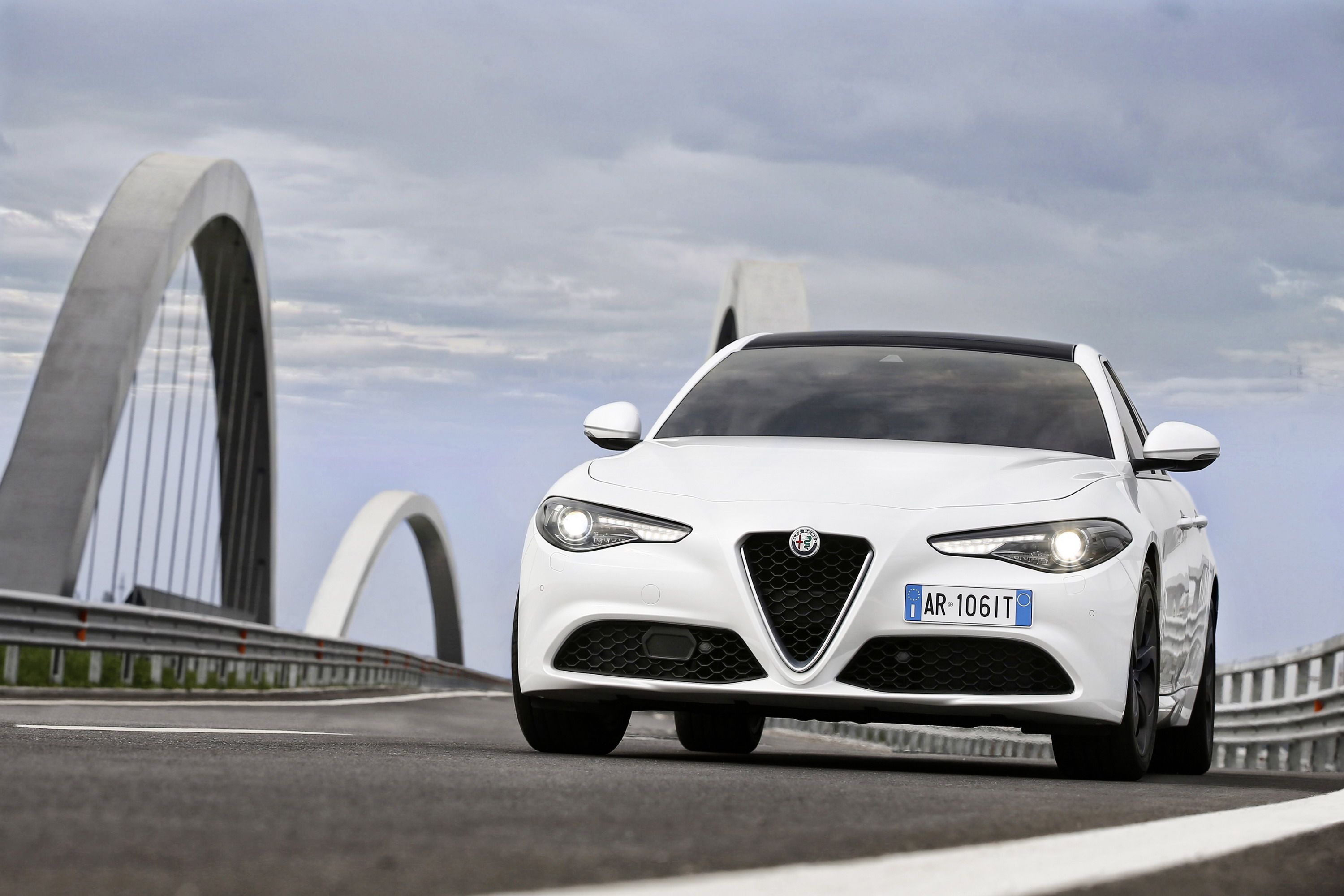
|
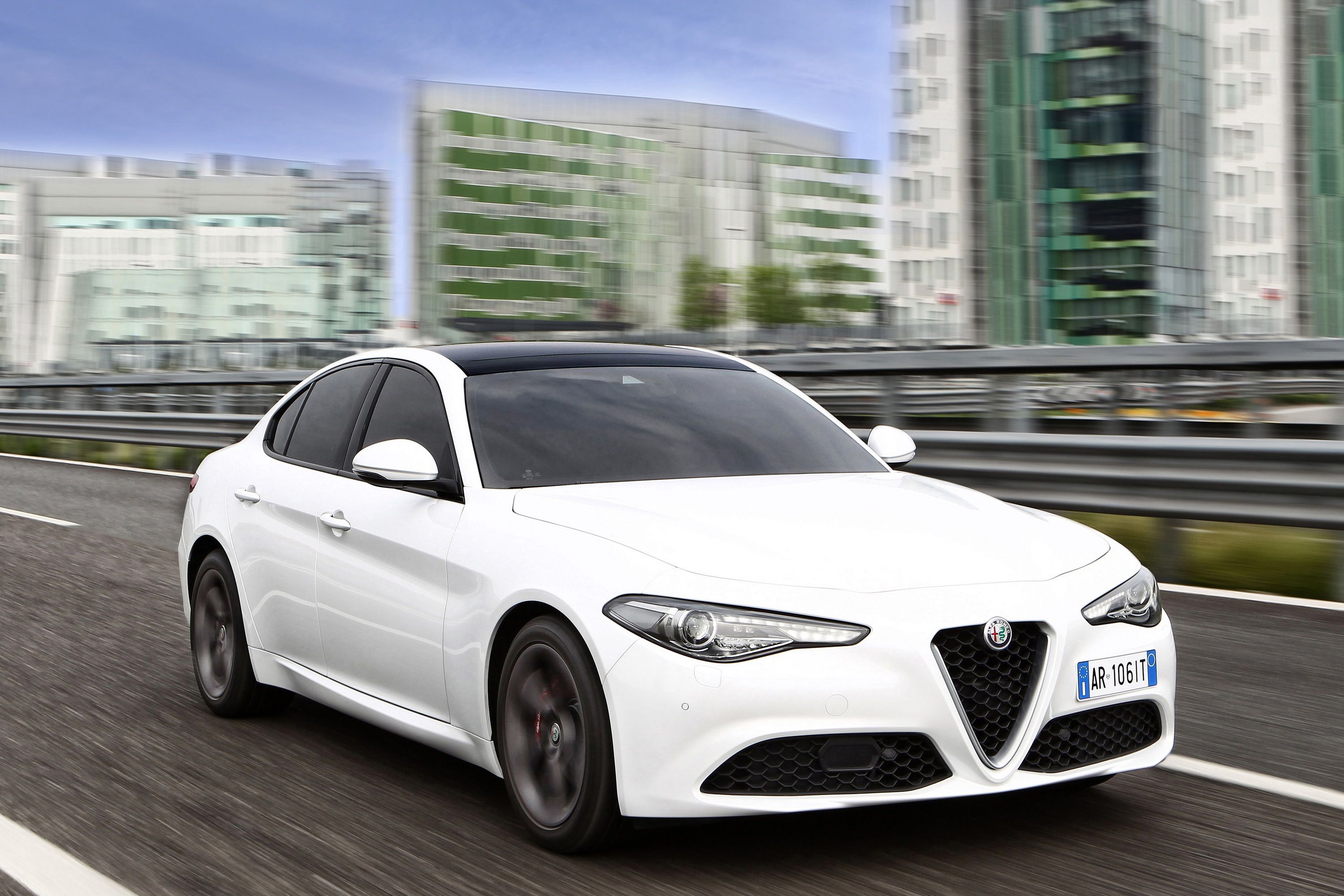
|
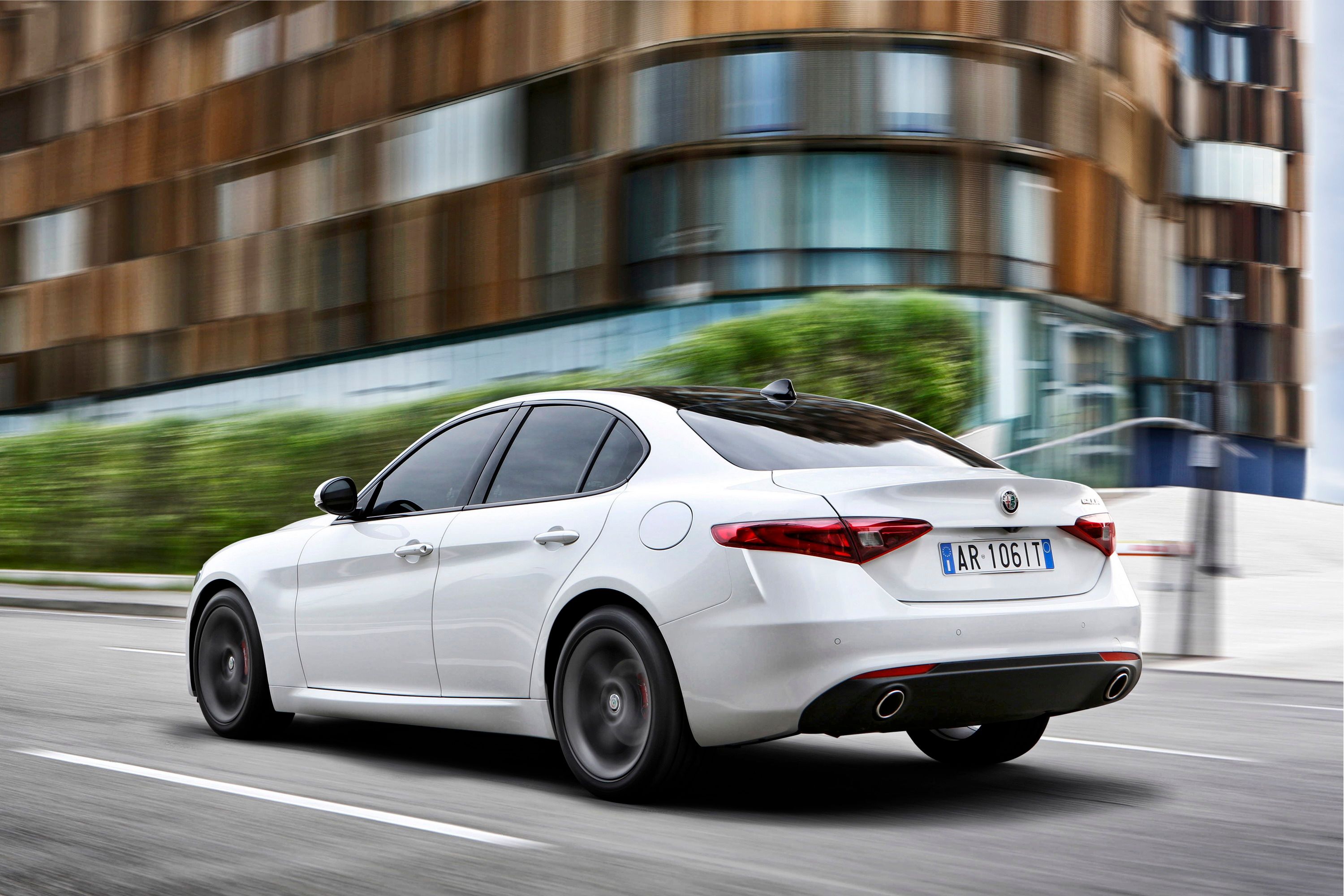
|
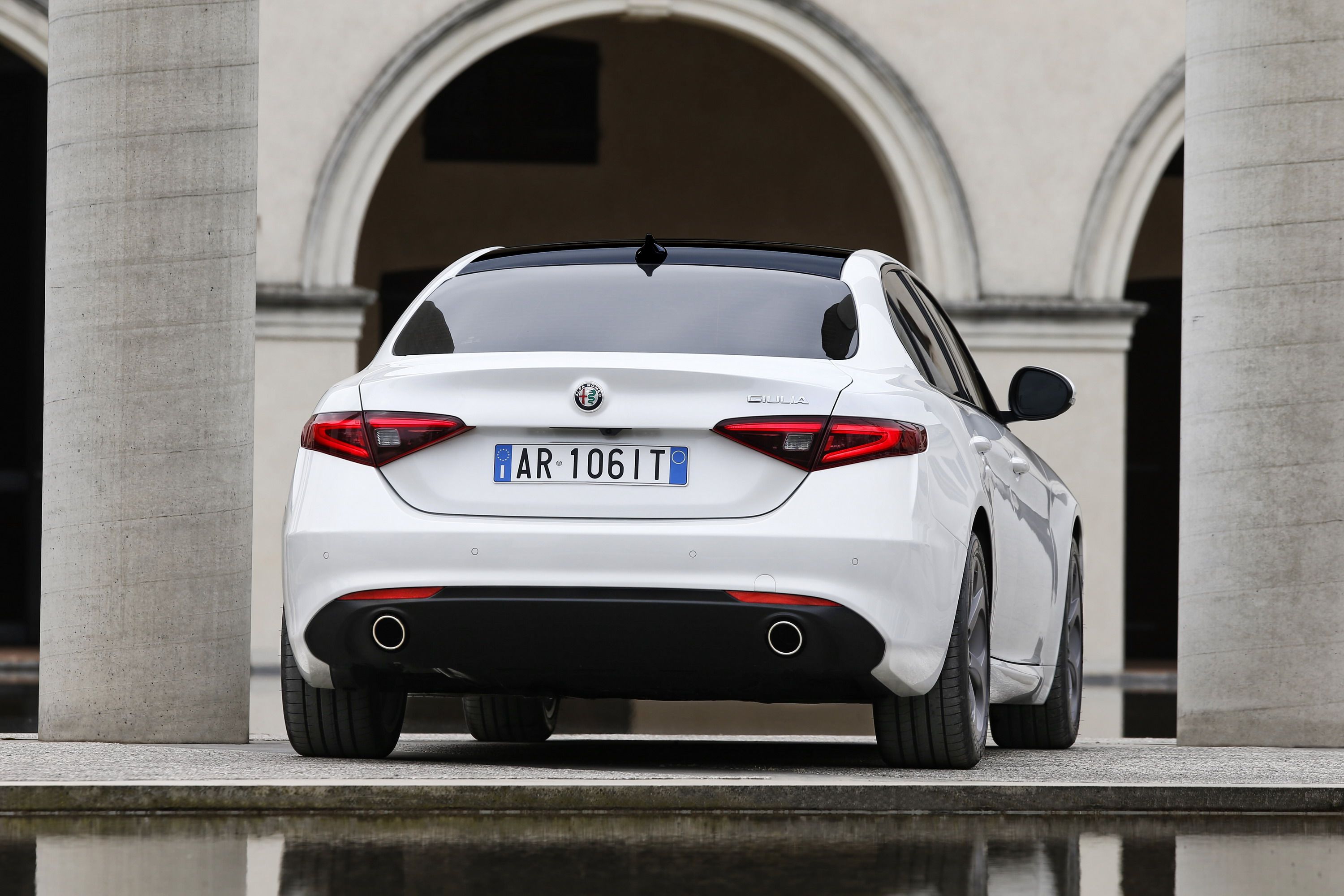
|
To the sides, the base-model Giulia isn’t all that different from the QV. Alfa even used the same wheels from the QV on the base model. The only really difference is that Alfa left out the small vent on the fender. To the rear, we see the same taillights from the QV, but the decklid doesn’t have the small spoiler that we saw on the QV. The rear diffuser has been significantly toned down, and this new, smoother unit makes way for a single, chrome exhaust outlet on each corner, with reflectors positioned above them.
All in all, Alfa didn’t do too bad with the exterior of the new base-model Giulia. I honestly expected it to be toned down a lot more than it is. So on the outside, the Giulia holds up pretty well, but what about the Inside?
The Competition
When it comes to the competition, it’s a good-ole Italian, German, American showdown. On the German side, you’ve got the Mercedes C-Class (top, left) and the BMW 3 Series (top right). On the American side, you’ve got the ringer known as the Cadillac ATS (bottom.) The C-Class was brought into a new generation for the 2015 model year, featuring a design inspired by the Mercedes F800 Concept from a few years back. Sticking with traditional German styling, the C-Class gets a sporty exterior package that includes a large vent in each corner of the front fascia to go with a dominating grille and air dam. The hood features smoothly contoured and curved lines on the outside edges with a defining and dominating center line. The side profile was updated to include a sharp character line toward the bottom of the doors, and a sleek look a little below the waistline. The rear end has an equally sporty fascia with a unique, full-width body line that transitions into thin, vertical rear vents. There is also a diffuser-like element with a body-colored insert in the center and a rectangular exhaust outlet on each side.
Where models like the Giulia and C-Class use a curvy design, the BMW 3 Series is the exact opposite. The front fascia comes to the party with sharp, geometric styling that creates sculpted air inlets, a wide-mouth air dam that is also tall, and there are those BMW Kidney grilles that are unmistakable. Like the Giulia, the 3 Series is long with stretched out headlights and a relatively smooth side profile. The hood features gentle contour lines, but nothing dramatic enough to write home about. The side skirts on the 3 Series are actually a bit more aggressive than those on the Giulia but are still simple enough that they don’t draw too much attention.
Around back, the 3 Series has taillights that are divided between the rear quarters and the rear deck lid. The license plate sits within a deep recess in the decklid that swoops outward at the bottom to create a shelf-like look. Down below, there isn’t a diffuser to speak of, but there is a sculpted protrusion on each corner that curves downward toward the ground on the outside. The exhaust outlets aren’t exactly centered, but they sit farther inward than that of the C-Class or the Giulia. If toned-down looks are what you’re going for, you the 3 Series will certainly suit your needs.
Finally, we’ve got the American contender that is almost as young as the Giulia in this segment. Being introduced for the 2013 model year, the ATS comes with traditional GM styling with a luxurious twist that brings aggressiveness and style together in one package. The front grille is larger like that of the C-Class, while the air dam and corner vents down below are small and integrated together. Thin, vertically oriented fog lights sit in the corners of the fascia. The hood has gentle character lines, while the side profile is more sculpted – similar to that of the Giulia and the C-Class. Around back, the ATS gets taillight units that are typical of GM – all red and fairly boring – while the decklid gets a high-mounted brake light that runs nearly the whole width of the deck lid. There are some sharp contour lines on the vertical surface of the decklid while a trapezoidal cutout serves as a home for the license plate. Down below, the rear fascia mimics the decklid and has a vertical character line right in the middle. A diffuser-like insert sits at the bottom, with exhaust pipes even closer to the middle than those of the 3 Series.
|
Mercedes C-Class |
BMW 3 Series |
Cadillac ATS |
|
|
Wheelbase (Inches) |
111.8 |
110.6 |
109.3 |
|
Overall length (Inches) |
184.5 |
182.8 |
182.8 |
|
Overall height (Inches) |
56.8 |
56.3 |
55.9 |
|
Overall width (Inches) |
71.3 |
71.3 |
71.1 |
All told, I couldn’t blame you for wanting to choose the Giulia or either of the German models over the ATS, but if you really like American designs, the ATS is for you. All four models are beautiful in their own right, but the Giulia and the C-Class are the more aggressive choices. On a side note, the ATS is also available in “V” form, which comes with very aggressive styling and enough power on tap to compete with the Quadrifoglio if that’s really your thing.
Interior
Inside the cabin has been equipped with what Alfa calls the “human-machine interface.” All basic controls, including the start button, are built into the steering wheel. Then down on the console, there are two knobs that are used to control Alfa DNA or the 8.8-inch Connect 3D Nav infotainment system. That infotainment system is equipped with voice activation and offers connectivity with mobile devices running Apple iOS or Android. The system used high-resolution 3D maps and Dead Reckoning technology – a system that can reroute you even without a GPS signal.
Behind the steering wheel sits and instrument cluster with either a 3.5-inch or seven-inch display, depending on the model. Information delivered on the instrument cluster depends on what DNA mode is selected, but includes lateral acceleration readings, fuel consumption readings, and suggest shift points. A Harmon Kardon South Theatre system comes as standard, offering up 900 watts of power from its 12-channel D-class amplifier. A total of 14 speakers are positioned throughout the cabin – pretty much making the Alfa a concert hall on wheels.
As you can see from the images here, the cabin is wrapped graciously in fine leather. The dash is smooth with a circular HVAC vent on each corner and two rectangular vents below the infotainment display. From the images, we can tell there are at least two interior options to choose from. Option for all black gets you black leather seating and black leather throughout with black trim inserts positioned here and there. The other confirmed option is Tan and Black with wood grain inserts. In this configuration, the top of each door panel is black, as is the top of the dash. Woodgrain inserts are installed around the door hands, below the upper dash pad and on the center console. The rest of the cabin, including the carpet, center console, and seats are all tan.
The Competition
When it comes to the inside of these luxurious sedans, the Giulia is hard to beat. Maybe it’s the fact that it’s a fresh and new design, or maybe it’s the fact that it’s just that nice. Either way, purchasing based on interior amenities and design alone would be a challenging task. See, the C-Class (top left) and 3 Series (top right) both have the German touch to them, while the Cadillac (bottom) actually branches out a bit from traditional GM design, but still has that American feel.
Going with the C-Class will get you an interior with few buttons as most features are controlled from the infotainment display or the thumb controls on the steering wheel. The standard C-Class doesn’t get a fully digital instrument cluster, but there is a small display located between the two, larger analog gauges. The infotainment display itself is just seven-inches, but if you opt for the Comand Online system, that gets updated to 8.4-inches. The display itself sits atop the center stack and looks like it’s floating, which leaves plenty of room for triple HVAC vents just below it and the minimalist center console and stack. A small door ahead of the shifter opens up to review cup holders while there’s a split armrest father back. The interior is available in a two-tone configuration, which usually comes with most of the trim panels and dash in one color while the seats and various trim inserts provide a healthy hint of contrast. On the technology front, you’ll find dual-zone climate control, electrically adjustable seats, Bluetooth phone connectivity, and an SD card reader. There are lots of options, some of which include navigation with three years of map updates, voice control, Sirius XM, and a Wi-Fi hotspot to name a few. Like the 3 Series, the C-Class has an option for ambient lighting as well.
Moving on, the 3 Series offers a slightly different take on German engineering. The dash features a weird comb-over like effect on top that creates a multi-tiered look. Like the C-Class, the infotainment display floats above the center stack, however, the overall design of it makes it look like part of the screen is being cut off by the dash. A two-tone interior is standard, with the top of the dash, roof, pillars, and most of the door trim in a darker color, while the lower portion of the dash, door trim inserts, seats, and center console lid all get a lighter contrasting color. In entry-level form, the car comes standard with BMW’s 6.5-inch iDrive system with a 6.5-inch screen, and eight programmable buttons. Sound is sent through a 205-watt Hi-Fi sound system with a total of nine speakers, two of which are tweeters. Sirius XM isn’t standard, but the wiring is there so adding an XM tuner is a breeze.
Finally, we get to the American-built Cadillac ATS. One look inside, and you’ll know that this baby was designed here in the U.S. For one, it doesn’t have a floating infotainment display or a smooth transition between the instrument cluster and the infotainment system like you find in the Giulia. As such, it’s not quite as clean of a look. That is partially made up for when it comes to the lack of buttons, though, as GM as integrated most of the controls into the center stack and steering wheel. This allows for a thin center console compared to all of the other models we’ve discussed. For being a Cadillac, though, the infotainment display and center stack is pretty Cruze-ish, which is a pretty big letdown for something that’s supposed to be more luxurious. The only color contrast you get is from trim inserts, however, the inserts on the steering wheel and center stack are gloss black, adding a bit of shine to the ride. On the technology front, you get an eight-inch display, 4G hotspot, and Bluetooth connectivity, among other things. The sound from the infotainment system is routed through a Bose sound system, so you know the audio quality will be noteworthy.
|
Mercedes C-Class |
BMW 3 Series |
Cadillac ATS |
|||
|
Mercedes C-Class |
BMW 3 Series |
Cadillac ATS |
37.1/37.1 |
40.3 |
38.6/36.8 |
|
Headroom front/rear (Inches) |
41.7/35.2 |
42.0/35.1 |
42.5/33.5 |
||
|
Legroom front/rear (Inches) |
TBA |
55.1/55.1 |
55.2/53.9 |
||
|
Shoulder room front/rear (Inches) |
TBA |
TBA |
53.0/52.3 |
Drivetrain
As expected, the 2.9-liter, 505 horsepower, biturbo engine has been reserved only for the Giulia Quadrifoglio. The non-Quadrifoglio models are offered with a gasoline engine and two variants of a diesel engine in Europe. First up is an aluminum 2.0-liter four-cylinder engine. By use of a MultiAir electro-hydraulic valve actuator system, a 2-in-1 supercharging system, and direct injection, the 2.0-liter pumps out 197 horsepower and 243 pound-feet of torque. With this engine, power is sent to the rear wheels via a new, eight-speed automatic transmission.
The diesel offering comes in the form of a 2.2-liter four-cylinder. Depending on configuration, the diesel pumps out 180 PS (177 horsepower) and 331 pound-feet of torque or 150 PS (148 horsepower) and 280 pound-feet of torque. Either variant of the diesel engine can be paired with the new eight-speed automatic or a six-speed manual transmission.
In the U.S., however, the non-Quadrifoglio Giulia will arrive with only the 2.0-liter gasoline unit. The four-banger will crank out more ponies than its European sibling, being rated at 280 horses and 306 pound-feet of torque. All that oomph will travel to the wheels through an eight-speed automatic. Rear-wheel drive models will be able to sprint from 0 to 60 mph in 5.1 seconds and will max out at 149 mph. A Q4 all-wheel-drive system that can send up to 60 percent of the torque to the front axle will be offered as an option, but there’s no word yet on how it improves performance.
Under the metal, you’ll find the Giulia is equipped with an exclusive double wishbone suspension system that has a semi-virtual steering axis and a 4.5-link suspension with a solution for toe adjustment in the rear. The rear cross member is made of aluminum composite and plastic. Other weight savings can be found in the carbon fiber driveshaft and aluminum suspension frames. Needless to say, Alfa Romeo went out of its way to see that the Giulia had a well-distributed weight and a great power-to-weight ratio. It’s nice to see that Alfa didn’t leave the base model Giulia without some lightweight materials. It goes to show it is interested in selling the lesser models just as much as it is in selling the QV.
Competing Performance
This is where the competition gets a little wonky and hard to keep up with. For the most part, the Giulia and Giulia Ti will compete with the C300 (AWD models will compete against the C300 4Matic.) These models come with a 2.0-liter four-cylinder under the hood that delivers a fair 241 horsepower and 273 pound-feet of torque. It’s not quite as good as what the Giulia offers, and performance suffers because of that. With a curb weight of 3,417 pounds, the C300 can hit 60 mph in six seconds. Top speed hasn’t been officially announced, but you can bet it is electronically limited to 155 mph, if it can even get that high. Fuel economy, however, is estimated at 24 mpg in the city and 34 mpg on the highway, which really isn’t too bad at all.
On the suspension front, the C-Class gets four-wheel independent suspension with a four-link system up front and five-arm multilink system out back. On a side note, there’s also a C350e Hybrid that offers up 275 ponies and 443 pound-feet of torque, and, if you’re looking to compete against the Giulia Quadrifoglio, you can up the ante with the Mercedes-AMG C43 that has a 3.0-liter V-6 rated at 362 horsepower and 384 pound-feet of torque or the C63 and C63 S that come with 469 ponies and 479 pound-feet or 503 horsepower and 516 pound-feet, respectively. C43 will get you to 60 mph in 4.6 seconds, while the C63 gets there in 4.0 seconds and the S model gets there in 3.9 seconds.
The 3 Series is just as bad as the Mercedes with more trim levels than you can count on one hand. However, if you really want something that competes with the Giulia, you need to avoid the entry-level and diesel models. On that front, you get a 2.0-liter four-cylinder that delivers just 180 horsepower and gets you to 60 mph in a sluggish 7.4 seconds. Moving up to the 330i will get you a bit closer with the same 2.0-liter, but it’s rated at 248 horsepower and 258 pound-feet of torque. 60 mph comes in as fast as 5.5 seconds with the automatic transmission while top speed is limited to 155 mph. Then you’ve got the range-topper of the non-M models that is known as the 340i sedan. This model uses a 3.0-liter inline-six that delivers a decent 320 horsepower and 330 pound-feet of torque. You’ll hit 60 mph in as fast as 4.8 seconds with the automatic, but you’ll still be restricted from going faster than 155 mph. All of these models can be equipped with BMW’s xDrive system for a small premium. Finally, at the top of the line is the BMW M3. It makes use of the same 3.0-liter, but it's tuned to pump out 425 ponies and 406 pound-feet. You’ll move to 60 mph in 3.9 seconds with the automatic transmission, but you won’t go over 155 mph. This model comes in at about $64,000, however, so it kind of falls in the middle between the Giulia Ti and the Giulia Quadrifoglio.
Our American fighter does come correct in its own right as far as performance goes, but you’ll have to move up from the entry-level model to get power comparable to the Giulia. The entry-level model gets a 2.5-liter with 202 horsepower and 191 pound-feet of torque. Like the 3 Series, it really doesn’t compete with 60 mph coming in at 7.5 seconds. It maxes out at a boring and American 130 mph. But, you can go with the 2.0-liter Turbo model that will get you closer to where you want to be with 272 horsepower and 295 pound-feet. It still won't take the Giulia in the 60-mph sprint, though, as it comes in at 5.9 seconds. It does max out at 149 mph, so you’ll eventually match the Giulia’s speed – you just won’t get there quite as fast. Finally, there’s the 3.6-liter that pumps out a cool 321 horsepower and 275 pound-feet. It’ll move you to 60 mph in 5.2 seconds with all-wheel drive, but top speed is unknown as of the time of this writing. Finally, if you’re trying to compete with the Quadrifoglio, you’ll have to look to the ATS-V sedan. More aggressive inside and out, you get 464 horsepower and 445 pound-feet of torque from that twin-turbo 3.6-liter engine. 60 mph will come as quick as 3.48 seconds with a maximum speed of 185 mph. That puts it just slightly faster to 60 than the Quadrifoglio, but the QV will still beat you on the Nürburgring as it is the fastest production sedan on the iconic track to date.
|
Mercedes-Benz C300 |
Mercedes-AMG C63 |
Mercedes-AMG C63 S |
BMW 330i |
BMW 340i |
BMW M3 |
Cadillac ATS 2.0 |
Cadillac ATS 3.6 |
Cadillac ATS-V |
|
|
Engine |
2.0-liter inline-4 turbo |
4.0-liter V-8 |
4.0-liter V-8 |
2.0-liter TwinPower Turbo inline 4-cylinder |
3.0-liter TwinPower Turbo inline 6-cylinder |
3.0-liter M TwinPower Turbo inline 6-cylinder |
2.0L Turbo DI VVT |
3.6L V-6 DI VVT |
3.6L V-6 Twin-Turbocharged |
|
Horsepower |
241 HP @ 5,550 RPM |
469 HP @ 5,500-6250 RPM |
503 HP @ 5,500-6250 RPM |
248 HP @ 5,200 RPM |
320 HP @ 5,500 RPM |
425 HP @ 5,500–7,300 RPM |
272 HP @ 5,500 RPM |
335 HP @ 6,800 RPM |
464 HP @ 5,850 RPM |
|
Torque |
273 LB-FT @ 1,300-4,000 RPM |
479 LB-FT @ 1,750-4,500 RPM |
516 LB-FT @ 1,750-4,500 RPM |
258 LB-FT @ 1,450–4,800 RPM |
330 LB-FT @ 1,380–5,000 RPM |
406 LB-FT @ 1,850–5,500 RPM |
295 Lb-FT @ 3,000-4,600 RPM |
285 LB-FT @ 5,300 RPM |
445 Lb-FT @ 3,500 RPM |
|
Transmission |
7G-TRONIC 7-speed |
7-speed AMG SPEEDSHIFT MCT |
7-speed AMG SPEEDSHIFT MCT |
8-speed Sport Automatic |
8-speed Sport Automatic |
6-speed manual |
TREMEC TR3160 |
Hydra-Matic 8L45 |
TREMEC TR6060 |
|
Fuel economy city/highway/combined |
24/34 |
18/24 |
18/24 |
23/34/27 |
21/32/25 |
17/26/20 |
21/30 |
20/30 |
16/24 |
|
0-60 mph |
6.0 seconds |
4.0 seconds |
3.9 seconds |
5.5 seconds |
3.9 seconds |
4.8 seconds |
5.4 seconds |
5.4 seconds |
4.2 seconds |
|
Top Speed |
130 mph |
180 mph |
186 mph |
130 mph |
130 mph |
155 mph |
145 mph |
146 mph |
189 mph |
|
Weight |
3,417 Lbs |
3,829 Lbs |
3,856 Lbs |
3,541 Lbs |
3,575 Lbs |
3,675 Lbs |
3,373 Lbs |
3,812 Lbs |
Safety
The Giulia comes with a number of safety features as standard equipment, depending on the trim level in question. Things like torque vectoring, the active aero splitter, and chassis domain control is only available on the Giulia QV. The lesser trim levels of the Giulia come standard with an integrated brake system. This system combines stability control and a traditional brake system.
Instant brake response allows for record-breaking stopping distances, with the Giulia stopping from 62 mph in just 115.5 feet. Forward collision warning, automatic emergency braking with pedestrian detection, and lane departure warning also comes standard. Optional features include adaptive cruise control and blind spot monitoring. These optional features should be available in the second half of 2016.
2017 Alfa Romeo Giulia small overlap IIHS crash test
2017 Alfa Romeo Giulia moderate overlap IIHS crash test
2017 Alfa Romeo Giulia side IIHS crash test
Pricing
Pricing for the Giulia isn’t all that bad. The entry-level model starts out at $37,995 plus taxes, options, and a $995 destination charge. The Giulia Ti comes in at just $39,995 plus the extras, while the Quadrifoglio nearly doubles in price at $72,000 plus a $1,595 destination charge (apparently it costs more to ship the QV model, huh?) The Quadrifoglio can only be had in rear-wheel drive, but the lower trim levels can be upgraded to Alfa’s Q4 all-wheel-drive system for an extra $2,000, which is well worth it to have the extra traction.
Competing prices
On the American front, you can get an ATS sedan for as little as $34,595 in entry-level form or as much as $47,990 for the Premium Performance trim. Then there’s the ATS-V Sedan which commands more like $60,695 out of the gate. Moving over to the 3 Series will have you paying a minimum of $33,450 for the non-competitive 320i or as much as $49,900 for the 320-horsepower 340i xDrive. The M3 Sedan starts out at $64,000. On the Merc side of things, you can roll out of the dealership with a C300 with a rear-wheel drive configuration for $39,500m but can pay $2,000 more for all-wheel drive. The C350 Plug-in model will set you back $45,490 while the AMG models start out at $52,00 and climb to as much as $72,800 for the C63 S Sedan.
|
BMW 320i Sedan |
$33,450 |
|
BMW 320i xDrive Sedan |
$35,450 |
|
BMW 328d Sedan |
$40,250 |
|
BMW 328d xDrive |
$42,250 |
|
BMW 330i Sedan |
$38,750 |
|
BMw 330i xDrive Sedan |
$40,750 |
|
BMW 340i Sedan |
$47,900 |
|
BMW 340i xDrive Sedan |
$49,900 |
|
BMW M3 |
$64,000 |
|
Mercedes C300 Sedan |
$39,500 |
|
Mercedes C300 4MATIC Sedan |
$41,500 |
|
Mercedes-AMG C43 Sedan |
$52,000 |
|
Mercedes-AMG C63 Sedan |
$65,200 |
|
Mercedes-AMG C63 S Sedan |
$72,800 |
|
Cadillac ATS |
$35,590 |
|
Cadillac ATS Luxury |
$39,390 |
|
Cadillac ATS Premium Performance |
$47,990 |
|
Cadillac ATS-V |
$60,695 |
Other Options
Audi A4
The A4 entered its fifth generation for the 2016 model year that brought about a mild evolution at best. It does have a more refined grille to go with new exterior lighting (LED,) and updated MMI infotainment system, 4G LTE hotspot, and finally Audi’s virtual cockpit. It’s nowhere near as stylish and aggressive as the Giulia, but it’s not an ugly car either, assuming you don’t mind Audi’s styling cues. The interior is stylish but has the same German feel to it that the C-Class and 3 Series bring to the table, including the floating infotainment display on the top of the dash. As far as power output goes, you can get a 2.0-liter gasoline unit that delivers 252 horsepower and 273 pound-feet of torque. It’s not quite enough to keep up with the Giulia, however, with getting to 60 mph taking 6.1 seconds and top speed limited to 130 mph. Pricing starts out at $34,900 and climbs to as much as $45,900 in Prestige trim. All-wheel drive is available on all trim levels, so you can at least get Audi’s awesome Quattro system.
Read more about the Audi A4 here.
Infiniti Q50
The Q50 is also a prime competitor in this niche and was actually updated for the 2016 model year. To be honest, the Q50 (on the outside) is like a weird mix between the Cadillac ATS and the Mercedes C-Class with a front end that slants downward a bit. The interior is clean but exceptionally rounded, which gives the interior a really unique feel. Leather and wood trim is available, while the center stack actually has dual touchscreen displays – take that Bimmer, Merc, and Alfa. Like some of the German competition, the Infiniti has a big handful of trim levels, half of which come equipped with a 2.0-liter four-banger that delivers 208 horsepower and fuel economy that comes in at 22 mpg in the city and 28 mpg on the highway. The next engine in line is a 3.0-liter V-6 with 300 horsepower. This engine loses two mpg in the city but gets 29 mpg on the highway. There’s a hybrid with 360 horsepower on tap that can achieve 27 mpg in the city and 32 mpg on the highway, but the best model out there is the Sport 400 trim that comes with 400 ponies on tap. Of course, fuel economy isn’t the best at 19 mpg in the city and 26 mpg on the highway. You can get into a base-model Q50 for as little as $33,950, but if you want the range-topping Red Sport 400, you’ll have to pony up $50,700.
Find out more about the Infiniti Q50 here.
Conclusion
I have to say I’m quite impressed with how Alfa Romeo handled the Giulia after already seeing the Giulia QV a while back. Normally, we get a base model and speculate for months about the range-topping models like the QV. In this case, I was actually expecting the lesser Giulia to be cheaply thrown together, but that wasn’t what happened at all. Alfa appears to have put considerable time into creating a model that was different than the QV without removing all the luxurious amenities that makes the car so desirable. In the end, if you’re looking for a fast and powerful sedan, you’ll want to go for the QV, but if it comes to having a family car that is more than comfortable, the lesser of the two will be a fine and suitable choice.
Updated History
Updated 03/21/2016: The new Alfa Romeo Giula will be making its North American debut at the 2016 New York Auto Show. On The U.S. market, Giula will be offered in standard and Ti versions, both featuring a 2.0 liter gasoline engine.
Updated 03/01/2016: The standard Alfa Romeo Giulia made its world debut at the 2016 Geneva Motor Show.


